Subaru has carved a distinct path in the automotive landscape with its mix of practicality, performance, and rugged charm. From sports coupes that hug the road to all-wheel-drive SUVs ready for weekend escapes, Subaru’s cars often punch above their weight. In this guide, we’ll take a closer look at 30 Subaru car models — their design, interiors, performance, and how they stack up in today’s market. Whether you’re curious about the sporty BRZ or the family-friendly Outback, you’ll find honest, clear insights here to help you understand what makes each Subaru tick.
1. Subaru BRZ
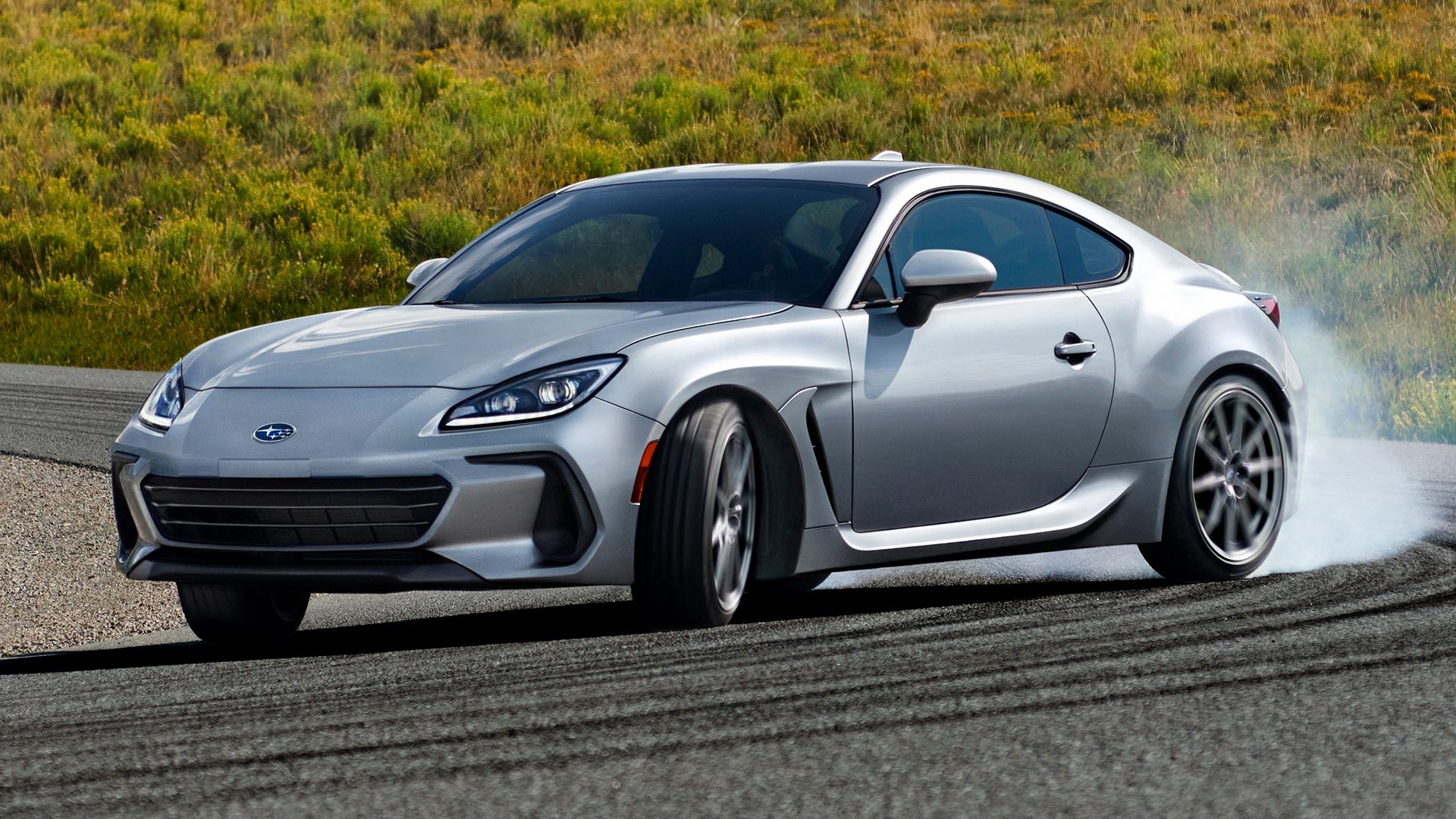
Exterior Design and Build Quality
The Subaru BRZ stands as Subaru’s pure sports coupe — sleek, low, and intentionally driver-focused. The design is aerodynamic, featuring a long hood, short rear deck, and a wide stance that screams balance and agility. Unlike Subaru’s typical rugged vehicles, the BRZ is rear-wheel drive, emphasizing its performance DNA. The build feels solid, with tight body lines and functional vents that manage airflow efficiently rather than serving as decoration.
Interior and Comfort
Inside, the BRZ offers a cockpit designed around the driver. The seats sit low, giving you that race-car feeling without sacrificing comfort. The materials are a mix of soft-touch plastics and Alcantara-style upholstery in higher trims. While space in the rear seats is limited (and best reserved for small luggage), the driver and passenger seats are supportive enough for long drives. The minimalist layout keeps distractions at bay.
Technology and Features
The BRZ’s infotainment system includes an 8-inch touchscreen with Apple CarPlay and Android Auto. Subaru intentionally kept the system simple, focusing on driving rather than gadgets. Digital instrumentation provides crisp graphics, and the steering wheel controls are intuitive.
Performance and Driving Experience
Powered by a 2.4-liter naturally aspirated boxer engine, the BRZ produces around 228 horsepower and 184 lb-ft of torque. The low center of gravity, courtesy of Subaru’s boxer engine layout, gives it exceptional balance through corners. You can choose between a six-speed manual or automatic transmission, but purists will argue the manual is the true experience. On twisty roads, the BRZ feels alive, eager, and connected — like a dance partner that responds to every move.
Fuel Economy and Efficiency
Expect around 20–21 mpg in the city and up to 30 mpg on the highway. For a sports car that loves to rev, that’s respectable efficiency.
Practicality and Storage
It’s a sports coupe, so practicality isn’t its strongest suit. However, the rear seats can fold down, extending the trunk’s modest cargo area — enough for a weekend bag or a set of golf clubs.
Safety and Reliability
Subaru’s EyeSight driver-assist tech is available on automatic models, offering adaptive cruise control and pre-collision braking. The structure is sturdy, and Subaru’s reputation for long-lasting reliability extends here too.
Pricing and Value
Starting around $30,000, the BRZ remains one of the best value sports cars on the market. Few cars deliver this much driving joy at such a reasonable price.
Pros and Cons Summary
- Pros: Engaging handling, affordable sports car feel, reliable engineering.
- Cons: Tight rear seats, limited cargo space, firm ride.
Performance and Comparison
Compared to the Toyota GR86 (its twin under the skin), the BRZ feels slightly more planted and balanced in turns. It’s less about raw speed and more about the connection between driver and road.
2. Subaru WRX
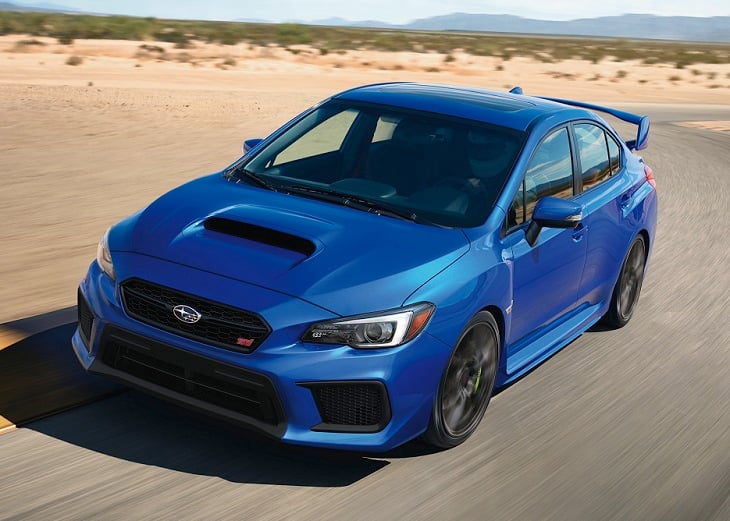
Exterior Design and Build Quality
The Subaru WRX carries the spirit of rally racing to everyday roads. Its aggressive front fascia, hood scoop, and wide stance signal that this sedan means business. Built on Subaru’s Global Platform, it feels sturdy and confident, whether cruising downtown or blasting through winding mountain passes.
Interior and Comfort
Inside, the WRX balances sporty flair with practicality. The front seats are bolstered to hold you in place during spirited driving, while the cabin materials have improved significantly in recent years. Rear passengers enjoy decent legroom, making the WRX suitable as both a fun daily driver and a weekend thrill machine.
Technology and Features
The WRX includes a vertically oriented 11.6-inch infotainment screen with Subaru’s latest multimedia system, plus smartphone integration. Audio quality is solid, and climate controls are responsive and simple.
Performance and Driving Experience
A 2.4-liter turbocharged boxer-four pushes out around 271 horsepower. Power delivery is linear, and the grip from Subaru’s symmetrical all-wheel-drive system is phenomenal. The manual transmission offers crisp shifts, while the CVT option caters to those who prefer convenience. The WRX feels composed, even on wet or uneven roads — a true performance sedan for all seasons.
Fuel Economy and Efficiency
Expect around 22 mpg combined. The turbo engine offers punchy performance but does demand premium fuel.
Practicality and Storage
With a trunk that comfortably fits weekend luggage and a roomy cabin, the WRX easily doubles as a daily family car.
Safety and Reliability
EyeSight safety features come standard on automatic trims, including adaptive cruise and lane-keep assist. Subaru’s long track record for reliability continues with this model.
Pricing and Value
With a starting price near $32,000, it’s a performance bargain compared to European rivals like the Volkswagen Golf R or Audi S3.
Pros and Cons Summary
- Pros: Powerful turbo engine, AWD grip, fun yet practical.
- Cons: Firm suspension, CVT lacks excitement.
Performance and Comparison
The WRX sits between daily comfort and rally-inspired excitement. While not as refined as a BMW 3-Series, it offers way more character for the price.
3. Subaru WRX STI
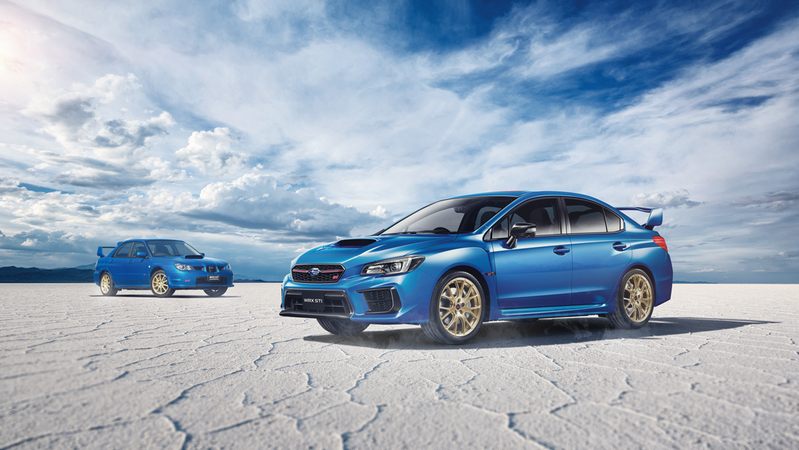
Exterior Design and Build Quality
The WRX STI is the WRX’s wild cousin — more aggressive, louder, and track-ready. Its massive rear wing, 19-inch wheels, and signature hood scoop give it a “don’t mess with me” stance. The build feels rock-solid, with every part tuned for high performance.
Interior and Comfort
The cabin shares its layout with the WRX but adds sporty accents — red stitching, performance gauges, and optional Recaro seats. Comfort is secondary to grip and control, but long drives remain bearable thanks to Subaru’s solid ergonomics.
Technology and Features
The STI includes Subaru’s multimedia setup, navigation, premium audio, and performance telemetry features. It’s more analog-feeling than modern performance sedans — and fans love it for that.
Performance and Driving Experience
Under the hood sits a 2.5-liter turbocharged boxer engine pushing 310 horsepower. A six-speed manual is your only option. It’s loud, mechanical, and wonderfully engaging. The STI’s driver-controlled center differential (DCCD) lets you fine-tune torque distribution — a feature few cars offer at any price.
Fuel Economy and Efficiency
Efficiency isn’t the STI’s priority — around 19 mpg combined — but the thrill per gallon is unmatched.
Practicality and Storage
Like the WRX, the STI is a four-door sedan with real trunk space, making it usable as a daily driver despite its rally pedigree.
Safety and Reliability
The WRX STI’s reliability is proven, but maintenance costs can be higher due to its performance components. Subaru’s build quality keeps it dependable for enthusiasts.
Pricing and Value
Priced around $40,000–$45,000, it competes with the Honda Civic Type R and Volkswagen Golf R — and holds its ground with pure mechanical joy.
Pros and Cons Summary
- Pros: Legendary performance, manual-only excitement, AWD precision.
- Cons: Thirsty engine, aging platform.
Performance and Comparison
Few cars connect you to the road like the WRX STI. It’s raw and analog in a digital era — more engaging than the Golf R, though less refined.
4. Subaru BRAT
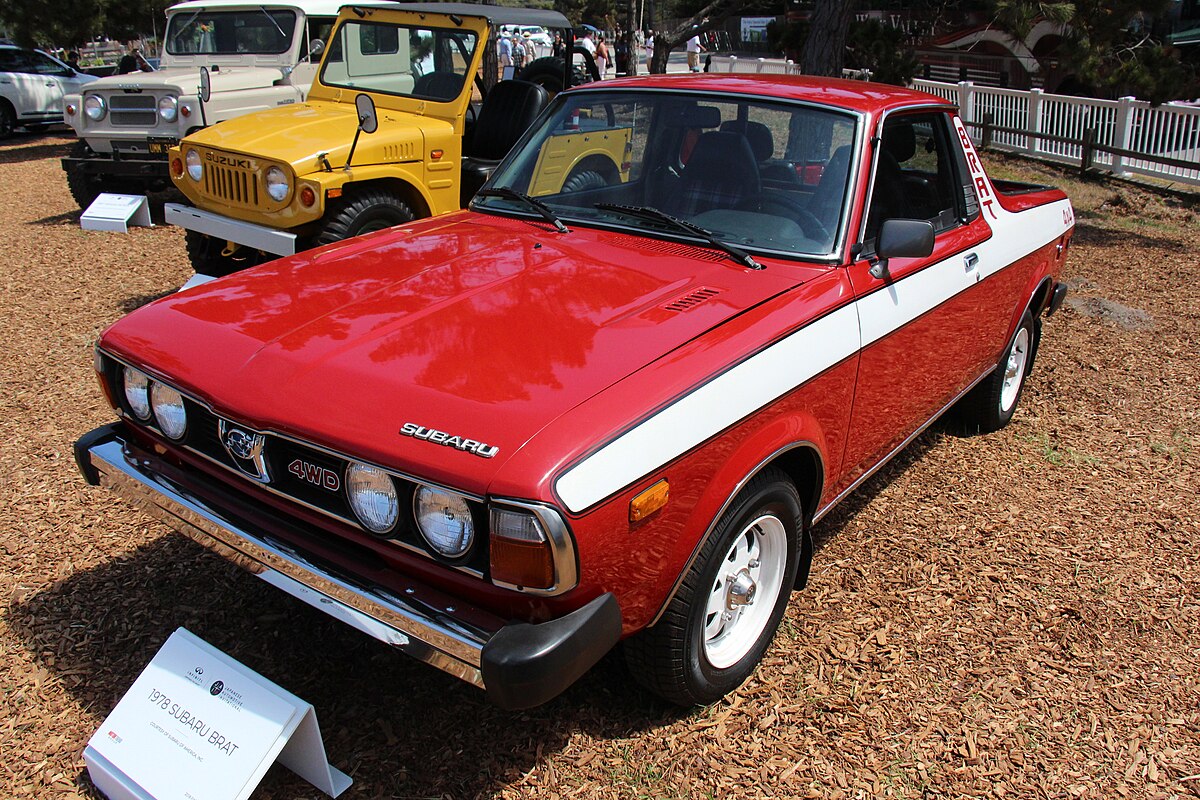
Exterior Design and Build Quality
The Subaru BRAT (Bi-drive Recreational All-terrain Transporter) from the late ’70s and ’80s remains one of Subaru’s quirkiest creations. Essentially a small pickup with car-like underpinnings, it featured jump seats in the bed — yes, actual seats — making it both weird and wonderful. Its boxy shape and compact frame gave it undeniable charm.
Interior and Comfort
The cabin was simple — no frills, just function. Vinyl seats, minimal controls, and a small dashboard made it feel utilitarian, but that was the point. It was a vehicle for adventure, not luxury.
Technology and Features
In its time, the BRAT offered 4WD engagement via a simple lever and a basic AM/FM radio. No touchscreens, no fancy driver aids — just honest simplicity.
Performance and Driving Experience
Under the hood sat a 1.8-liter flat-four engine, delivering modest power but excellent traction. Off-road, the BRAT was surprisingly capable, climbing trails that would make modern crossovers hesitate.
Fuel Economy and Efficiency
With its lightweight build, the BRAT managed over 25 mpg — impressive for a small utility vehicle of its era.
Practicality and Storage
The small bed limited serious hauling, but it handled bikes, gear, and surfboards with ease. Its dual personality — car and truck — made it oddly practical.
Safety and Reliability
Safety wasn’t its highlight, given the era, but reliability was excellent. Many BRATs still run today, a testament to Subaru’s engineering durability.
Pricing and Value
While no longer produced, restored BRATs fetch collector interest. Expect prices from $10,000 to $25,000 depending on condition.
Pros and Cons Summary
- Pros: Quirky design, off-road capable, easy to maintain.
- Cons: Basic interior, limited safety, rare parts today.
Performance and Comparison
The BRAT predates today’s small trucks like the Ford Maverick — but its spirit lives on in Subaru’s adventure DNA.
5. Subaru SVX
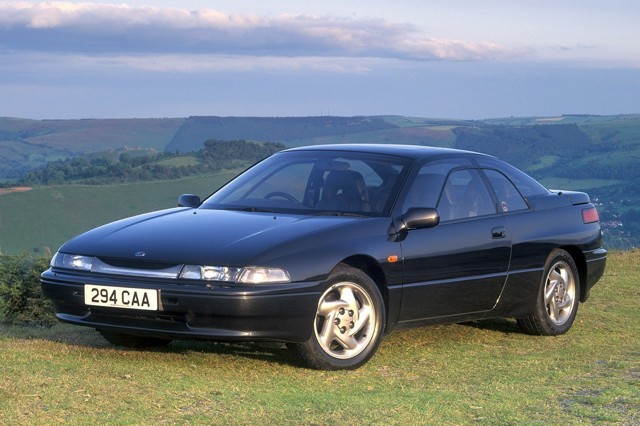
Exterior Design and Build Quality
Produced in the early ’90s, the Subaru SVX was Subaru’s ambitious luxury sports coupe — futuristic even by today’s standards. Its window-within-a-window design was iconic, and the body had an aerodynamic, flowing shape that set it apart from boxier rivals.
Interior and Comfort
The interior was plush for its era, with leather seating, power accessories, and a driver-centric dashboard. It was a comfortable grand tourer, ideal for long highway drives.
Technology and Features
The SVX came loaded with features for its time: automatic climate control, premium audio, and an advanced (for the era) AWD system. It was Subaru’s statement car — sophisticated yet distinctively Subaru underneath.
Performance and Driving Experience
Its 3.3-liter flat-six engine produced 230 horsepower, mated to an automatic transmission. The SVX was smooth and quick, if not razor-sharp. All-wheel drive added security and composure on slippery roads.
Fuel Economy and Efficiency
Fuel economy averaged around 18–24 mpg, fair for a heavy AWD coupe with a six-cylinder engine.
Practicality and Storage
The SVX offered a decent trunk and usable rear seats, making it surprisingly practical for a sports coupe.
Safety and Reliability
It was well-built but suffered from early transmission issues. Properly maintained models, however, remain reliable and collectible today.
Pricing and Value
Originally priced near $35,000 in the ’90s, used SVXs now range from $5,000 to $15,000, depending on condition.
Pros and Cons Summary
- Pros: Distinct design, smooth flat-six, AWD comfort.
- Cons: Weak transmission, thirsty engine, limited production.
Performance and Comparison
The SVX was Subaru’s boldest experiment — competing with the Nissan 300ZX and Toyota Supra. It wasn’t the fastest, but it was the most comfortable and refined.
6. Subaru Impreza WRX
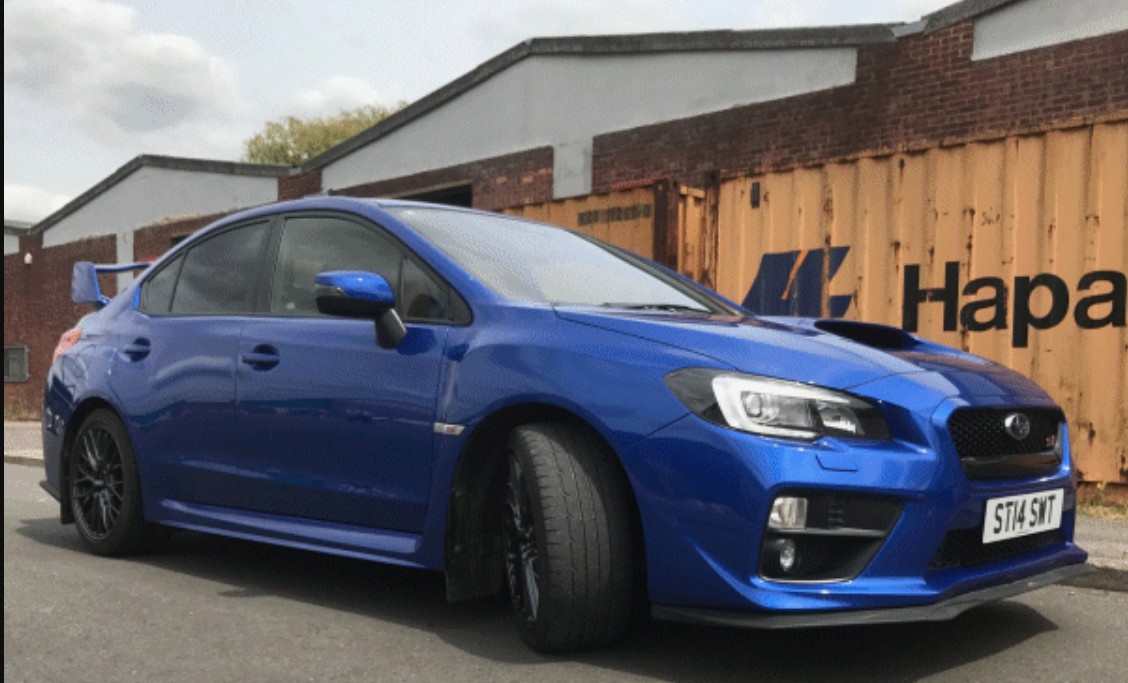
Exterior Design and Build Quality
The Subaru Impreza WRX began life as a rally-bred version of the humble Impreza compact sedan. Its body lines balance subtle aggression with daily practicality. The hood scoop, wide fenders, and performance stance instantly signal that this isn’t a regular commuter car. Build quality is typically Subaru—solid, functional, and engineered to take a beating on everything from asphalt to gravel.
Interior and Comfort
Step inside, and you’ll find a sporty yet approachable interior. The seats are supportive with bolstering that hugs you through sharp corners but remains comfortable on long drives. The rear cabin space is generous for its class, making it suitable for families who don’t want to give up fun for practicality. Soft-touch materials and clean design elevate it above the average compact car.
Technology and Features
Modern Impreza WRX models feature a touchscreen infotainment system with Apple CarPlay, Android Auto, and a suite of driver aids. Older versions rely on analog charm, but even then, Subaru prioritized function over flash—clear gauges, easy controls, and logical layouts.
Performance and Driving Experience
Equipped with a 2.0- or 2.5-liter turbocharged boxer engine, the Impreza WRX produces between 265 and 271 horsepower depending on model year. It’s paired with either a manual or CVT automatic transmission and Subaru’s symmetrical all-wheel drive system. The result? Outstanding grip, crisp cornering, and confident acceleration. The car feels equally at home tearing through twisty roads or commuting through rain-soaked traffic.
Fuel Economy and Efficiency
Fuel economy ranges around 20–27 mpg depending on driving style and transmission choice. It’s not an economy car, but it doesn’t drain your wallet either.
Practicality and Storage
As a compact sedan, the WRX offers good trunk space and folding rear seats. You can easily carry weekend gear or groceries without sacrificing performance flair.
Safety and Reliability
Subaru’s focus on safety continues here with EyeSight driver assistance features, solid crash ratings, and a track record of mechanical dependability. Regular maintenance is key for turbo longevity, but the WRX remains one of the more durable performance sedans in its class.
Pricing and Value
Pricing varies widely—used WRXs can be found for under $15,000, while new models start around $32,000. Considering its all-weather capability and punchy turbo engine, it’s a strong value play in the performance market.
Pros and Cons Summary
- Pros: Turbo power, AWD grip, daily usability.
- Cons: Firm ride, noticeable road noise, premium fuel required.
Performance and Comparison
The Impreza WRX squares off against the Honda Civic Si and VW GTI but stands apart with all-wheel drive and rally-bred personality. It’s the enthusiast’s choice for real-world driving excitement.
7. Subaru Impreza WRX STI
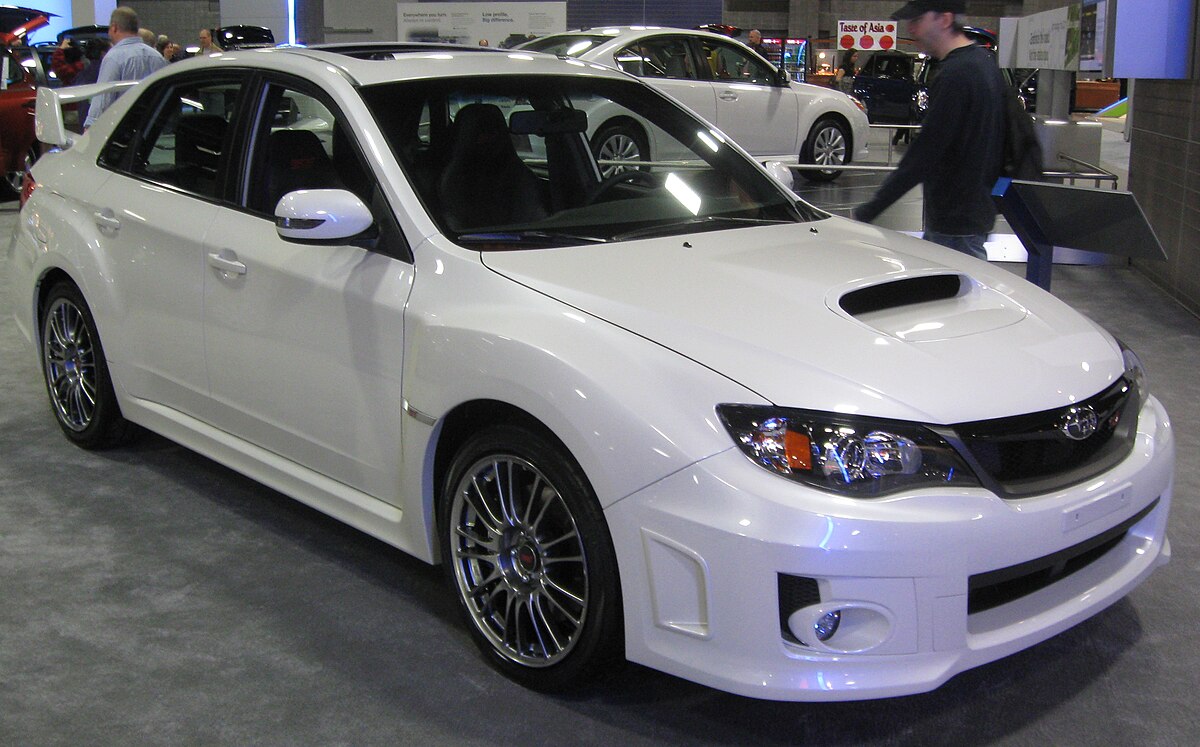
Exterior Design and Build Quality
Building on the WRX’s platform, the Subaru Impreza WRX STI takes aggression and performance up a notch. The wide-body design, prominent rear wing, and performance detailing make it unmistakable. Its sturdy frame and reinforced chassis handle track conditions with ease, making it one of the toughest compact performance cars ever built.
Interior and Comfort
The cabin leans more toward functionality than luxury, but it’s undeniably sporty. Deep bucket seats, STI badging, and a leather-wrapped steering wheel set the tone. It’s comfortable enough for commuting yet ready for weekend track days. Rear seat space remains practical for adults, a rarity in high-performance sedans.
Technology and Features
While not overly high-tech, it offers all the essentials—touchscreen infotainment, Bluetooth connectivity, and performance-focused driver info displays. What it lacks in digital flash, it makes up for in mechanical precision.
Performance and Driving Experience
The STI’s 2.5-liter turbocharged boxer engine pumps out 305+ horsepower through a six-speed manual transmission. Power delivery is thrilling, and the grip from the advanced AWD system with driver-controlled center differential is phenomenal. Whether cornering on a mountain road or blasting through snow, the STI feels planted and predictable. It’s not subtle—it’s a street-legal rally car.
Fuel Economy and Efficiency
Expect around 19 mpg combined—hardly frugal, but no one buys an STI to save gas. It’s about the drive, the sound, and the adrenaline.
Practicality and Storage
Despite its racing DNA, it still functions as a four-door family sedan with usable trunk space and foldable seats. That mix of thrill and utility is part of its charm.
Safety and Reliability
Subaru’s chassis engineering and AWD system add security in all conditions. While older STIs can be maintenance-intensive, newer models are remarkably dependable when properly serviced.
Pricing and Value
Used STIs start around $25,000, with new models previously retailing near $40,000. Considering its rarity and heritage, it holds value well among performance enthusiasts.
Pros and Cons Summary
- Pros: Explosive performance, manual-only fun, iconic styling.
- Cons: Harsh ride, high fuel consumption, dated tech in older versions.
Performance and Comparison
Versus rivals like the Civic Type R or Golf R, the WRX STI offers rawer feedback. It’s less refined but more visceral—a mechanical connection between car and driver that’s increasingly rare today.
8. Subaru Impreza Coupe
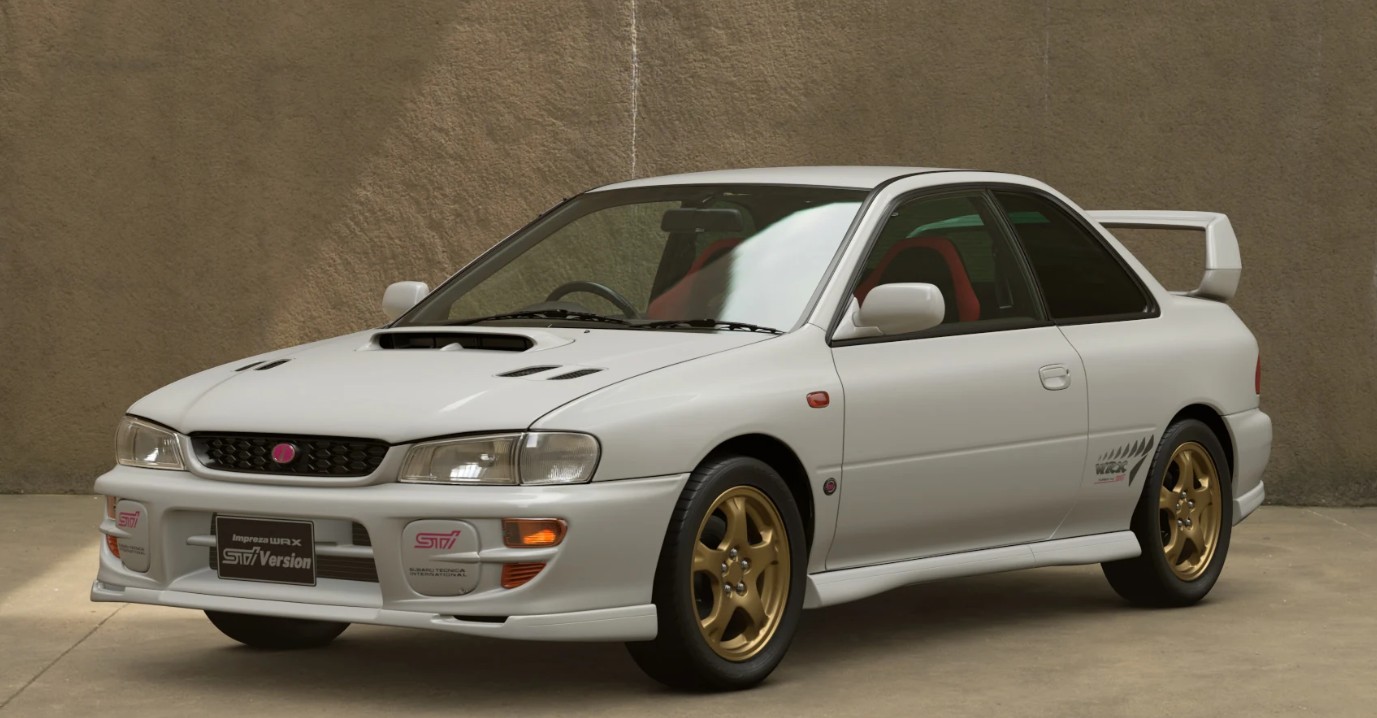
Exterior Design and Build Quality
The Subaru Impreza Coupe, produced in the late 1990s and early 2000s, brought two-door flair to Subaru’s rally-bred family. Its short wheelbase, wide stance, and clean proportions gave it a timeless appeal. Build quality was sturdy, reflecting Subaru’s commitment to reliability even in its sportier offerings.
Interior and Comfort
The interior is basic but functional. You’ll find straightforward controls, supportive seats, and solid ergonomics. While rear seats are tight, they’re serviceable for short trips. Drivers appreciate the uncluttered cockpit that encourages focus on the road ahead.
Technology and Features
Older Impreza Coupes feature analog gauges and manual climate controls—charmingly simple. Enthusiasts appreciate this analog nature, as it prioritizes connection over distraction. Some versions offered optional AWD and power accessories.
Performance and Driving Experience
Available engines ranged from efficient flat-fours to the turbocharged WRX variants. The AWD system transformed it into a nimble, confident performer on twisty backroads and slick surfaces alike. Its light weight gave it quick reflexes and plenty of fun factor.
Fuel Economy and Efficiency
Depending on configuration, fuel economy hovered around 25–30 mpg, making it efficient for a sporty compact of its era.
Practicality and Storage
While limited to two doors, the folding rear seats expanded cargo flexibility. You could load weekend luggage or sports gear without much fuss.
Safety and Reliability
Though safety technology was simpler then, the solid chassis and low center of gravity gave the Impreza Coupe stable handling. Reliability remains strong—many of these cars still run decades later with basic maintenance.
Pricing and Value
Because of its rarity, clean Impreza Coupes now attract collector interest. Expect prices between $8,000 and $18,000 depending on condition and trim.
Pros and Cons Summary
- Pros: Compact, engaging drive, classic Subaru styling.
- Cons: Tight rear seat, aging parts availability.
Performance and Comparison
Think of it as a smaller, more playful WRX. Compared to contemporary rivals like the Honda Integra, the Impreza Coupe offered superior traction and a sportier personality.
9. Subaru Impreza Sedan
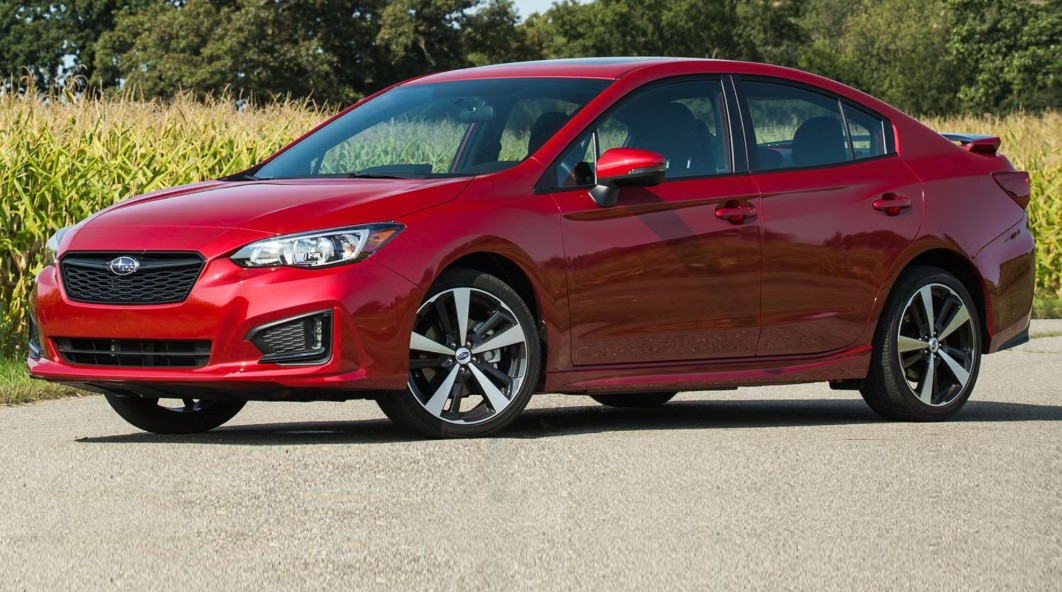
Exterior Design and Build Quality
The Subaru Impreza Sedan blends everyday practicality with confident design. Over the years, it’s evolved from a compact boxy car to a sleek, modern four-door. The craftsmanship is evident—tight panel gaps, corrosion-resistant construction, and Subaru’s signature solid feel.
Interior and Comfort
The cabin design emphasizes comfort and visibility. Soft-touch materials, ergonomic controls, and supportive seats make it feel more upscale than its price suggests. Cabin space is generous, and ride quality is smooth even on rough pavement.
Technology and Features
Current Imprezas come loaded with a Starlink infotainment system, smartphone integration, and advanced driver-assist technologies. Even base trims feel well-equipped, reflecting Subaru’s reputation for offering value.
Performance and Driving Experience
The standard 2.0-liter flat-four engine delivers adequate performance for daily driving, with 152 horsepower and a choice between manual or CVT transmission. It’s not a sports sedan, but its symmetrical all-wheel drive provides sure-footed handling through rain or snow. Steering is light yet precise, making it enjoyable for everyday use.
Fuel Economy and Efficiency
Expect around 28 mpg combined. It’s efficient enough for commutes while maintaining Subaru’s all-weather confidence.
Practicality and Storage
The sedan body style offers a sizable trunk, and folding rear seats increase flexibility. For small families, it’s a smart balance of space and drivability.
Safety and Reliability
The Impreza consistently earns top safety ratings. Subaru’s EyeSight system includes adaptive cruise control, lane departure warning, and pre-collision braking. Reliability is another strong suit; regular maintenance keeps it running for years without drama.
Pricing and Value
Starting around $22,000 new, the Impreza Sedan represents one of the most affordable AWD cars in America. Used examples are plentiful and budget-friendly.
Pros and Cons Summary
- Pros: Affordable AWD, comfortable cabin, smooth ride.
- Cons: Modest power, conservative styling.
Performance and Comparison
While it doesn’t match the excitement of the WRX, the Impreza Sedan outshines rivals like the Toyota Corolla and Honda Civic in bad-weather confidence and long-term durability.
10. Subaru Impreza Hatchback
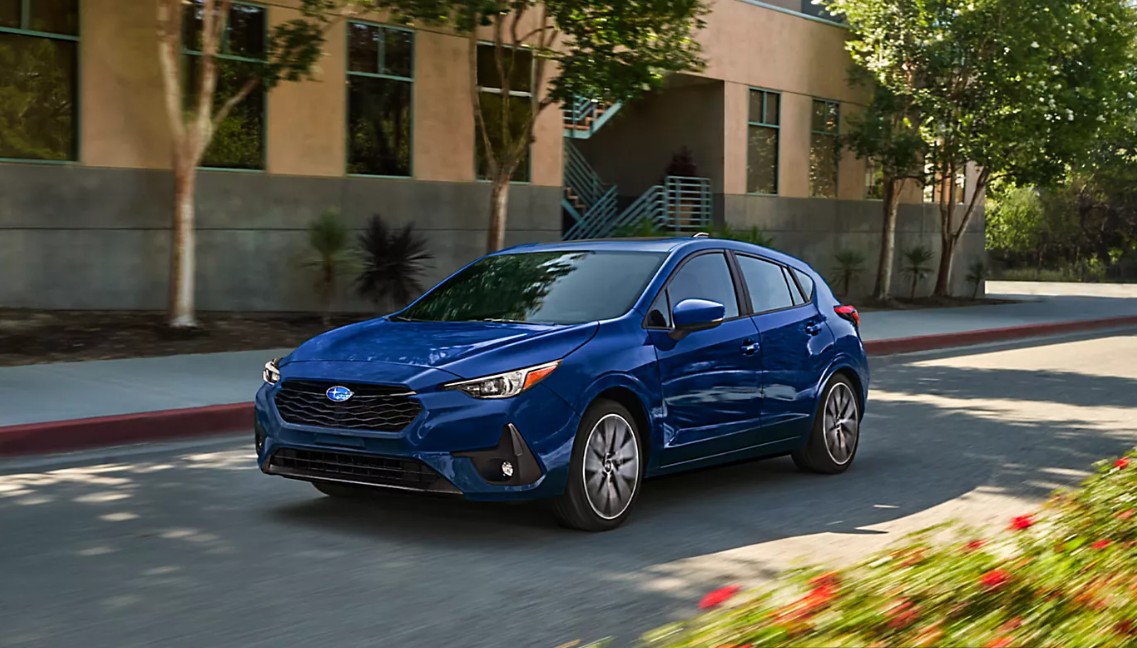
Exterior Design and Build Quality
The Impreza Hatchback adds practicality to Subaru’s compact lineup. Its sleek rear profile, integrated spoiler, and tidy proportions make it both stylish and functional. Subaru’s steel body structure is engineered for rigidity and safety while maintaining a lightweight feel.
Interior and Comfort
Inside, the hatchback mirrors the sedan’s comfort and quality but adds greater flexibility. The upright seating position provides excellent visibility, and high-grade materials create a refined atmosphere. It’s roomy for passengers and pets alike.
Technology and Features
Subaru equips the Impreza Hatchback with Starlink infotainment, voice controls, Apple CarPlay, and Android Auto. Higher trims include heated seats, premium audio, and push-button start—useful touches that make daily driving more enjoyable.
Performance and Driving Experience
The 2.0-liter flat-four engine offers steady, predictable performance. While not thrilling, it’s balanced and composed, especially with Subaru’s symmetrical AWD system keeping things stable on slippery roads. Ride comfort leans soft, ideal for urban commuting or highway cruising.
Fuel Economy and Efficiency
Fuel efficiency mirrors the sedan version—around 28 mpg combined—making it one of the most economical AWD hatchbacks in its class.
Practicality and Storage
With rear seats folded, cargo capacity expands dramatically. Whether hauling gear, luggage, or sports equipment, the hatchback shines as a versatile daily companion.
Safety and Reliability
Like its sedan sibling, the Impreza Hatchback scores high in crash safety and reliability. Subaru’s symmetrical AWD and EyeSight safety suite make it a dependable family choice.
Pricing and Value
Starting at roughly $23,000, it’s competitively priced against front-wheel-drive rivals yet offers far greater capability. The hatchback design also enhances resale value thanks to its utility.
Pros and Cons Summary
- Pros: AWD standard, excellent cargo space, refined ride.
- Cons: Average acceleration, conservative design.
Performance and Comparison
Compared to competitors like the Mazda3 Hatchback or VW Golf, the Impreza trades speed for traction and longevity. It’s a confident, capable all-rounder that makes sense for everyday drivers.
11. Subaru Outback
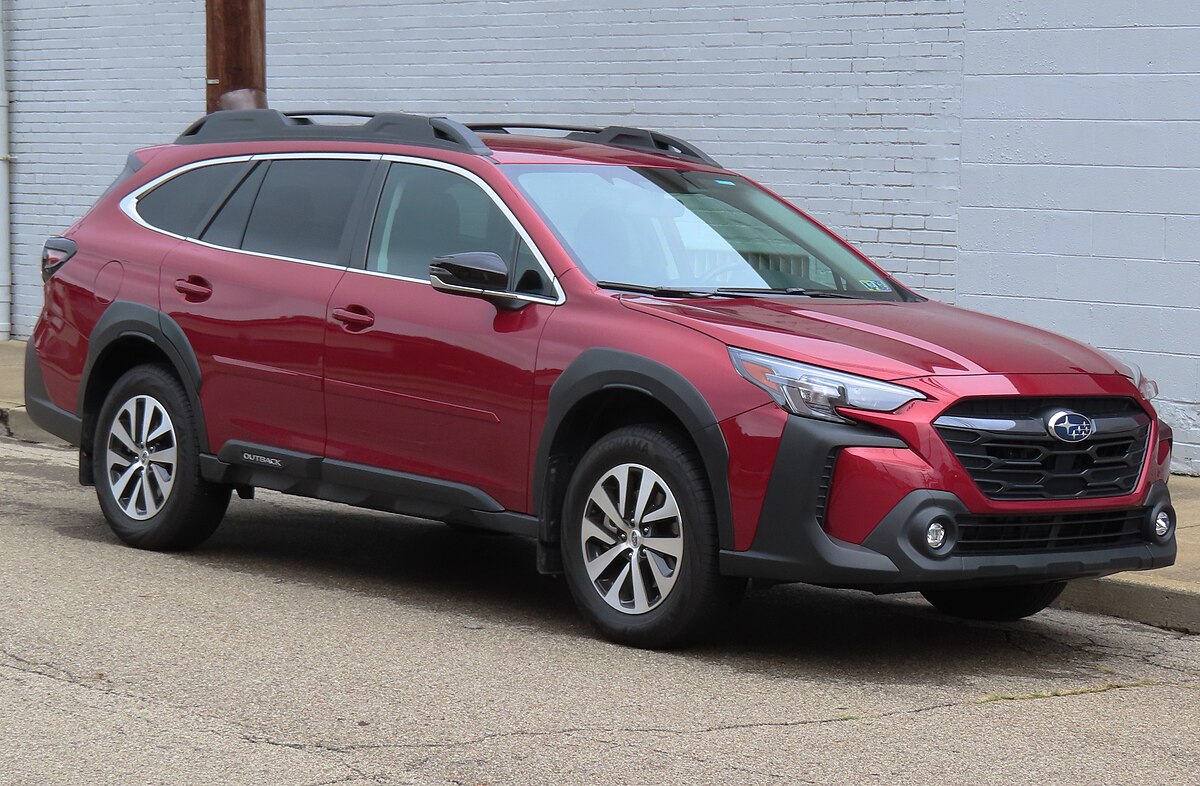
Exterior Design and Build Quality
The Subaru Outback blends wagon practicality with SUV toughness, a signature look that has aged gracefully. Its rugged body cladding, raised roof rails, and adventure-ready stance make it instantly recognizable. The front fascia, with its bold grille and LED headlamps, strikes a balance between refined and outdoorsy. The build feels substantial — doors shut with a satisfying thud, and the paint quality stands up well to dirt-road punishment.
Interior and Comfort
Inside, the Outback favors functionality with subtle touches of luxury. The seats are supportive for long hauls, and there’s generous head and legroom in both rows. Subaru’s choice of materials leans toward durable rather than plush, but upper trims add soft-touch panels and contrast stitching. The driving position offers a commanding view of the road, and the cabin is noticeably quieter than older generations.
Technology and Features
The current Outback comes with Subaru’s Starlink infotainment system displayed on a large vertically oriented touchscreen. Apple CarPlay and Android Auto are standard, and the interface is fairly intuitive after a short learning curve. Top trims include premium audio, built-in navigation, and a hands-free power liftgate. EyeSight Driver Assist Technology — with adaptive cruise, lane centering, and pre-collision braking — remains a standout.
Performance and Driving Experience
Two engine options define the Outback’s character: a 2.5-liter flat-four for efficiency and a 2.4-liter turbocharged boxer for extra punch. Both send power to Subaru’s symmetrical all-wheel drive via a CVT. The turbo makes highway merging brisk, while the standard engine focuses on smoothness. The suspension soaks up bumps with confidence, and the Outback feels stable even on gravel trails.
Fuel Economy and Efficiency
Expect around 26 mpg city and 33 mpg highway for the 2.5-liter, dropping slightly with the turbo. That’s respectable given its all-wheel-drive system and wagon-SUV proportions.
Practicality and Storage
The Outback’s 32.6 cu ft of cargo space expands to more than 75 cu ft with the seats folded — plenty for camping gear or a couple of bikes. Roof rails with integrated crossbars make it easy to carry kayaks or a cargo box. It’s the family road-trip hero in Subaru’s stable.
Safety and Reliability
EyeSight contributes to stellar safety scores from both NHTSA and IIHS. Reliability remains a Subaru strength; owners report few major issues when maintenance is kept up.
Pricing and Value
Starting around $29,000, the Outback offers genuine AWD utility and strong resale value. Higher trims with turbo power can approach $40,000, yet they still compete well against premium crossovers.
Pros and Cons Summary
- Pros: Excellent ride comfort, huge cargo space, standard AWD, great safety tech.
- Cons: CVT feel isn’t for everyone, base engine could use more punch.
Performance and Comparison
Against rivals like the Honda CR-V Hybrid and Toyota RAV4 Adventure, the Outback stands apart for its car-like handling and rugged charm. It’s the “Swiss Army knife” of family adventure vehicles.
12. Subaru Forester
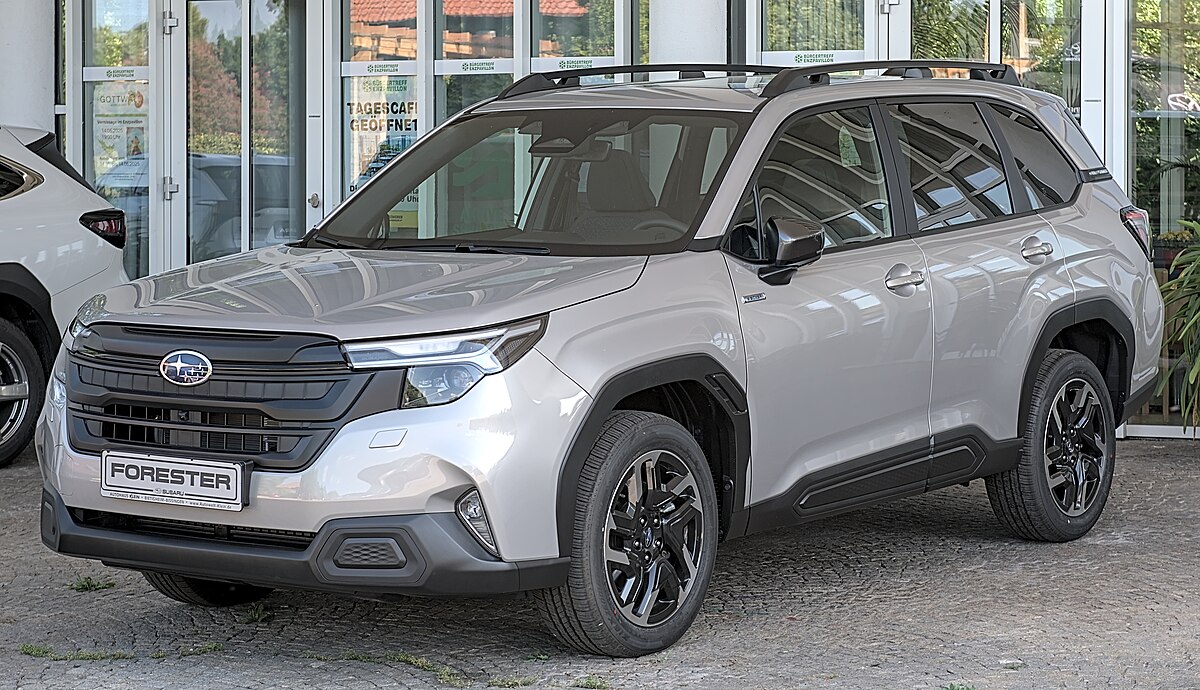
Exterior Design and Build Quality
The Subaru Forester continues its practical box-shaped tradition with modern refinements. Big windows, sharp LED lights, and a high ground clearance signal utility first. The structure feels stiff, lending the car a reassuring solidity on rough pavement.
Interior and Comfort
Inside, visibility is exceptional — a Forester trademark. The cabin is airy, with wide doors that make entry easy. Seats are firm yet comfortable, and there’s ample space in both rows. Higher trims include leather upholstery, a panoramic sunroof, and power adjustments.
Technology and Features
All Foresters feature Subaru’s Starlink infotainment on a touchscreen ranging from 6.5 to 8 inches. Connectivity is smooth, and EyeSight safety tech comes standard. Optional features include driver-monitoring cameras, heated steering wheel, and power tailgate.
Performance and Driving Experience
Power comes from a 2.5-liter flat-four producing about 182 hp. While not thrilling, it’s more than enough for daily driving. The CVT keeps things smooth, and AWD traction inspires confidence in wet or snowy conditions. Steering feels light and predictable, ideal for urban errands or forest trails.
Fuel Economy and Efficiency
The Forester manages roughly 26 mpg city and 33 mpg highway — impressive for a full-time AWD crossover.
Practicality and Storage
With 28.9 cu ft behind the seats (and 74 cu ft folded), it swallows groceries, luggage, or camping supplies with ease. The wide rear hatch opening is a blessing for bulky items.
Safety and Reliability
The Forester consistently earns top safety marks and is known for its long lifespan. Owners praise low maintenance costs and sturdy AWD components.
Pricing and Value
Base pricing hovers near $28,000, climbing to $37,000 for the Wilderness trim. Considering its capability and standard safety suite, that’s a strong value play.
Pros and Cons Summary
- Pros: Great visibility, roomy interior, strong safety record, all-weather traction.
- Cons: Modest power output, CVT drone under heavy throttle.
Performance and Comparison
Compared with the Toyota RAV4 and Mazda CX-5, the Forester emphasizes comfort and control rather than speed. It’s a dependable companion for families who value predictability over flash.
13. Subaru Crosstrek
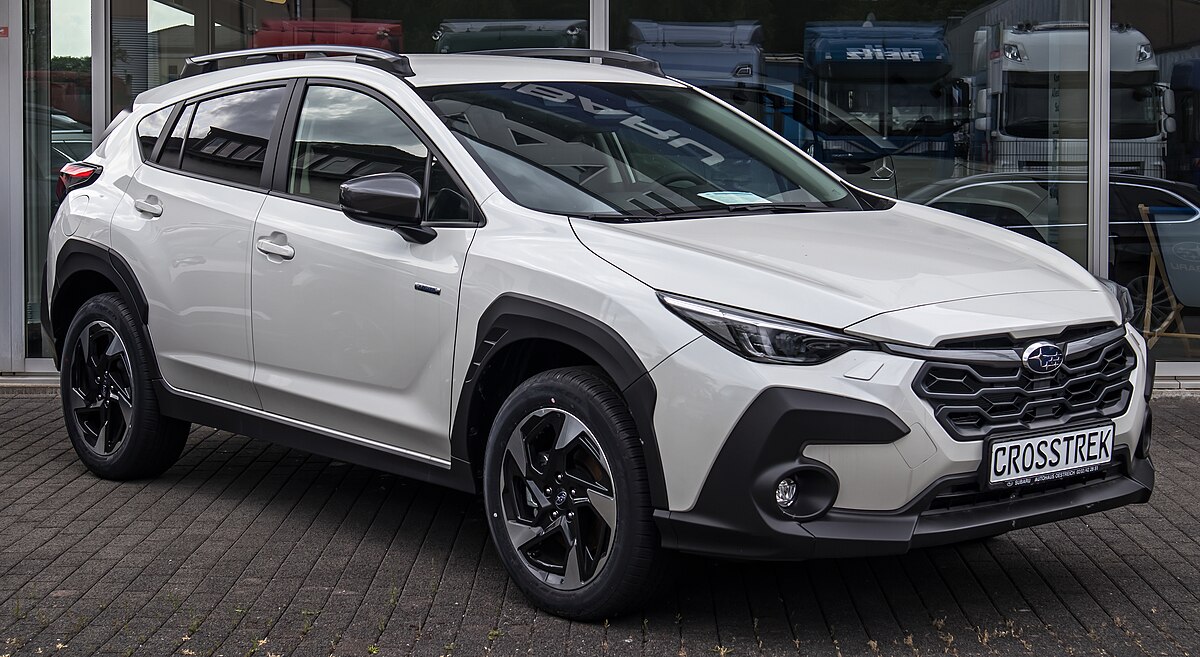
Exterior Design and Build Quality
The Crosstrek sits between hatchback and SUV, with its lifted stance and plastic cladding hinting at adventure. The design is playful yet purposeful. Subaru’s paint palette — including bright blues and yellows — adds personality without losing ruggedness.
Interior and Comfort
Cabin space feels generous given its compact footprint. Seats provide supportive bolstering, and rear passengers get decent legroom. The Crosstrek’s interior is easy to clean, making it a favorite for active lifestyles with pets or muddy boots.
Technology and Features
All models include smartphone connectivity and EyeSight safety features. The infotainment screen is responsive, and optional Harman Kardon audio upgrades sound crisp. A digital gauge cluster and adaptive headlights appear on higher trims.
Performance and Driving Experience
The standard 2.0-liter engine offers adequate pep, but the optional 2.5-liter delivers stronger acceleration. Handling is nimble, and the ride quality is cushioned enough for both city potholes and dirt roads. Its AWD setup makes it unusually sure-footed for this size class.
Fuel Economy and Efficiency
Expect around 27 mpg city / 34 mpg highway. That efficiency, combined with a 16-gallon tank, grants excellent range for road trips.
Practicality and Storage
Cargo capacity reaches 55 cu ft with seats folded. The tailgate opening is wide, and roof-rack mounting points simplify gear hauling. Compact dimensions make parking effortless.
Safety and Reliability
The Crosstrek maintains high safety ratings, and its reliability record mirrors that of the Forester — solid, simple, and low-drama ownership.
Pricing and Value
Starting near $25,000, the Crosstrek undercuts most competitors with standard AWD. Even the top trims stay below $33,000 with plenty of comfort features.
Pros and Cons Summary
- Pros: Excellent ride height, city-friendly size, good fuel economy, proven AWD.
- Cons: Base engine feels sluggish, cargo room trails larger SUVs.
Performance and Comparison
Compared with the Hyundai Kona and Jeep Renegade, the Crosstrek offers a smoother ride and better all-weather grip. It’s a compact crossover with a real sense of adventure.
14. Subaru Ascent
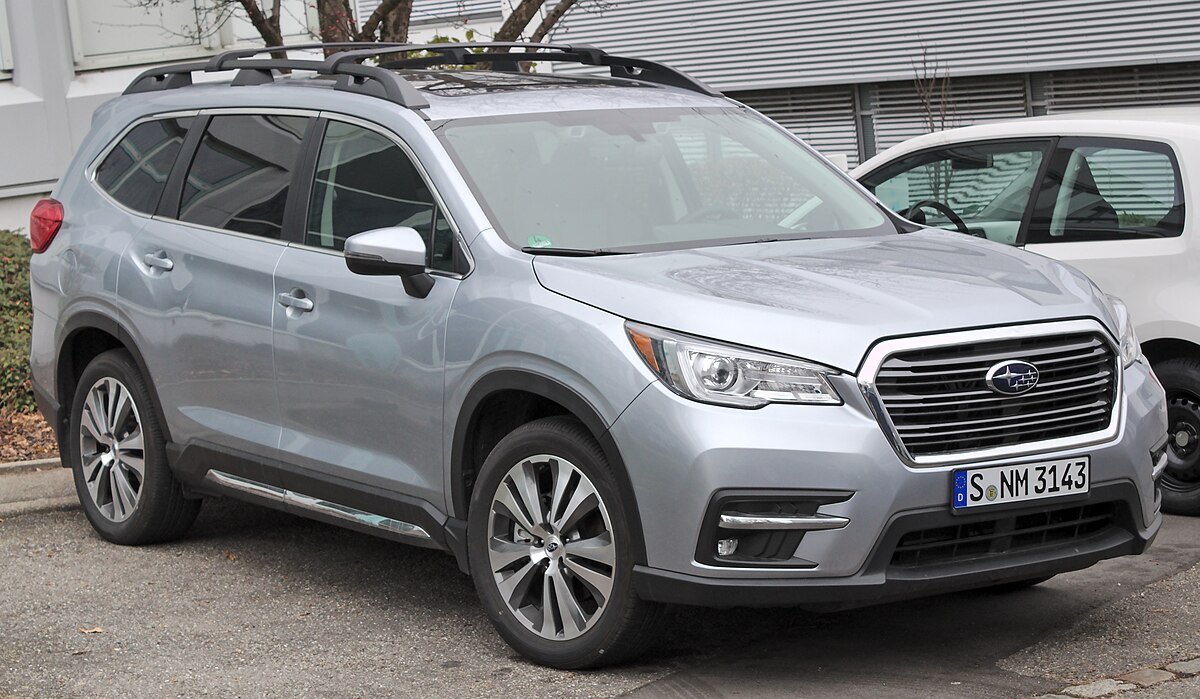
Exterior Design and Build Quality
The Ascent is Subaru’s largest SUV, designed squarely for families. Its styling mirrors the Outback but scaled up, with bold wheel arches and a wide stance. Build quality feels sturdy; panels line up cleanly and paint quality is premium.
Interior and Comfort
Inside, the Ascent accommodates up to 8 passengers with generous legroom in the first two rows and a usable third row. Cabin materials feel upscale, particularly on Limited and Touring trims. Road noise is minimal, and the suspension isolates bumps effectively.
Technology and Features
The Ascent’s 11.6-inch touchscreen dominates the dash. Wireless CarPlay, multiple USB ports, and tri-zone climate control come standard. Safety tech mirrors the rest of the Subaru lineup with EyeSight, plus optional rear-auto braking and surround-view cameras.
Performance and Driving Experience
A 2.4-liter turbocharged boxer-four provides 260 hp and 277 lb-ft of torque. Power delivery is smooth, and the AWD system offers impressive traction. Steering is light for its size, and highway stability is strong even with a full load.
Fuel Economy and Efficiency
Rated around 20 mpg city / 26 mpg highway, the Ascent balances size and efficiency decently. Its 19.3-gallon tank gives excellent cruising range.
Practicality and Storage
Behind the third row you’ll find 17.8 cu ft of space, expanding to 86 cu ft with seats down. Storage cubbies, cupholders, and USB ports abound — a thoughtful touch for family trips.
Safety and Reliability
The Ascent achieves strong crash-test ratings and has proven dependable since launch. Regular maintenance keeps the turbo engine happy for the long haul.
Pricing and Value
Pricing starts at $35,000 and rises to $48,000 for a fully loaded Touring. Given its features and AWD, it’s competitively priced among three-row SUVs.
Pros and Cons Summary
- Pros: Spacious interior, strong turbo engine, refined ride, comprehensive safety tech.
- Cons: CVT limits sporty feel, third-row access can be tight for adults.
Performance and Comparison
Compared with the Honda Pilot and Toyota Highlander, the Ascent stands out for its sure-footed AWD and comfortable road manners. It’s Subaru’s family flagship done right.
15. Subaru Solterra
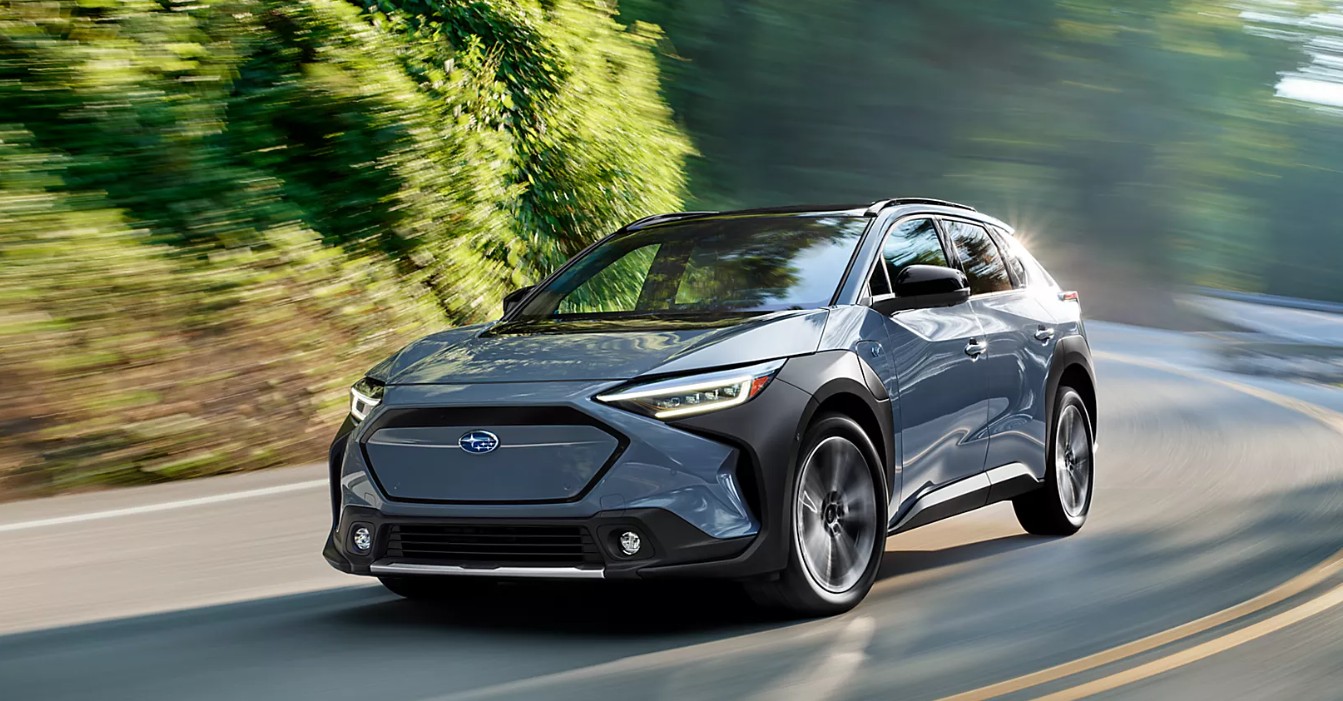
Exterior Design and Build Quality
The Solterra is Subaru’s first all-electric SUV, co-developed with Toyota. It shares some design DNA with the bZ4X but carries Subaru’s rugged cues — chunky fender flares, short overhangs, and practical ground clearance. The fit and finish feel premium, aligning with modern EV standards.
Interior and Comfort
The cabin feels futuristic yet familiar. A high digital cluster sits above the steering wheel, and the central touchscreen integrates most functions. Materials are eco-friendly, with soft fabric blends and recycled plastics. Passenger space equals that of a compact SUV, and the flat floor improves legroom.
Technology and Features
The Solterra comes loaded: wireless smartphone integration, adaptive cruise, 360-degree camera, and Subaru’s latest safety suite. Over-the-air updates keep software current. The infotainment interface mirrors Toyota’s clean design, quick and easy to use.
Performance and Driving Experience
Dual-motor AWD provides 215 hp and instant torque. Acceleration is brisk but smooth, and traction control keeps power delivery stable even on slippery surfaces. Ride comfort is composed, with a low center of gravity thanks to the battery placement.
Fuel Economy and Efficiency
EPA range estimates hover around 228 miles per charge. DC fast-charging up to 100 kW replenishes 80% in under an hour, making road-trip stops manageable.
Practicality and Storage
With 30 cu ft of cargo space and a roomy second row, the Solterra works well for daily family duties. AWD plus off-road traction modes give it light-trail capability uncommon in EVs.
Safety and Reliability
As Subaru’s first EV, long-term data is still building, but early owners report solid reliability. EyeSight-style driver assists are tuned specifically for electric operation.
Pricing and Value
Starting around $44,000, the Solterra qualifies for select incentives and offers AWD as standard — something few EVs at this price do.
Pros and Cons Summary
- Pros: Standard AWD, quiet and refined ride, solid range, comprehensive tech package.
- Cons: Range slightly behind some rivals, limited fast-charging network.
Performance and Comparison
Facing competitors like the Hyundai Ioniq 5 and Volkswagen ID.4, the Solterra shines with its traction and outdoor-ready attitude. It’s Subaru’s promising electric beginning, fusing tradition with technology.
16. Subaru Tribeca
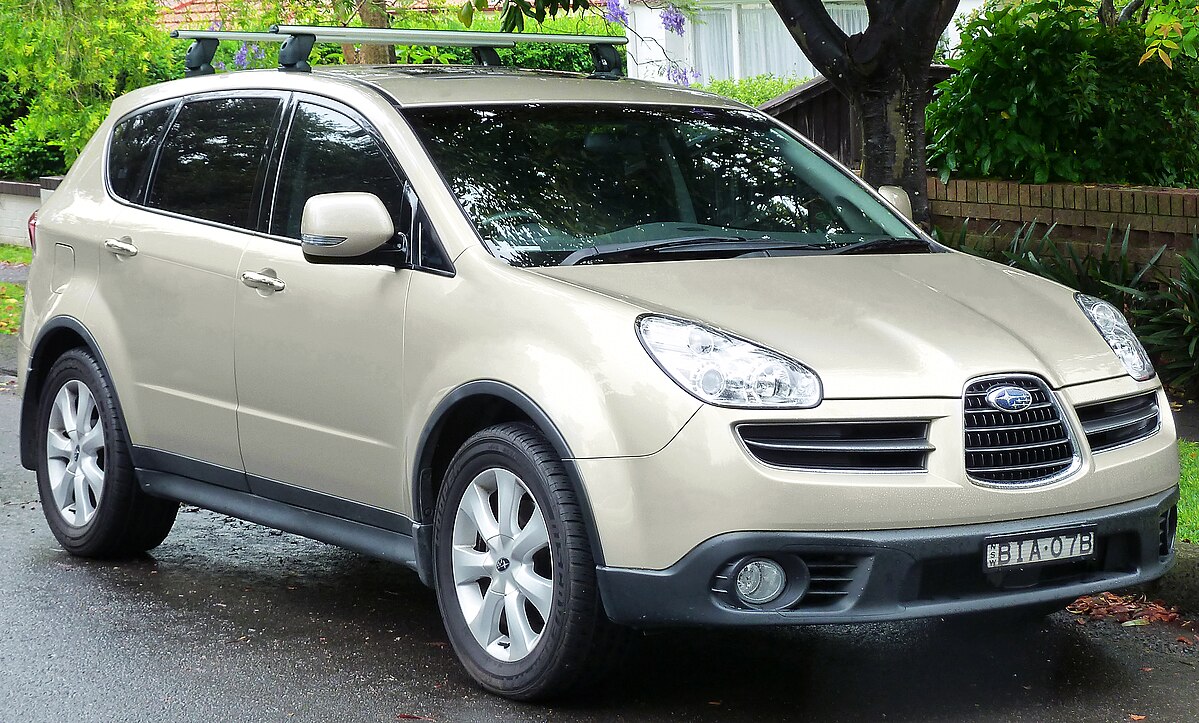
Exterior Design and Build Quality
The Subaru Tribeca was Subaru’s first attempt at a mid-size crossover, and while its styling divided opinions, it remains an important chapter in the brand’s history. The early “airplane nose” front end was quirky, later softened to a more conventional look. Build quality was solid — thick panels, tight seams, and a reassuringly heavy feel. Despite its unusual design, the Tribeca aged better than critics expected, especially the facelifted versions after 2008.
Interior and Comfort
The Tribeca’s cabin was upscale for its era, with a sweeping dashboard and soft materials uncommon in Subarus at the time. Seating for up to seven made it family-friendly, although the third row suited kids more than adults. Ride comfort was excellent, with good insulation from road noise and a stable suspension setup for long drives.
Technology and Features
For its mid-2000s debut, the Tribeca was ahead of its time: dual-zone climate control, power front seats, available navigation, and an optional rear-seat entertainment system. Later models introduced Bluetooth connectivity and a better infotainment interface. While dated by modern standards, these were impressive touches for Subaru’s first premium crossover.
Performance and Driving Experience
Under the hood sat a 3.6-liter flat-six engine delivering 256 horsepower — smooth, quiet, and reliable. Power went through a 5-speed automatic to Subaru’s symmetrical AWD system. The Tribeca handled more like a large sedan than an SUV, with predictable cornering and a composed highway ride.
Fuel Economy and Efficiency
Rated around 16 mpg city / 21 mpg highway, the Tribeca was not the most efficient, but it offered strong towing capacity and ample power for family trips.
Practicality and Storage
Cargo room measured 8.3 cu ft behind the third row, 37.6 cu ft behind the second, and 74.4 cu ft with all seats folded — competitive for the time. The flat floor and wide hatch simplified loading.
Safety and Reliability
Standard stability control, multiple airbags, and Subaru’s AWD gave the Tribeca solid safety credentials. Long-term reliability proved decent, with the flat-six known for its durability.
Pricing and Value
At launch, the Tribeca started around $30,000, climbing toward $40,000 with all options. While it struggled against luxury competitors, used examples now offer affordable entry into a comfortable AWD SUV.
Pros and Cons Summary
- Pros: Smooth flat-six engine, comfortable ride, strong build quality.
- Cons: Limited third-row space, dated infotainment, thirsty fuel consumption.
Performance and Comparison
Compared with the Toyota Highlander or Honda Pilot of its time, the Tribeca felt more solid and better-balanced on the road. It paved the way for the modern Ascent that replaced it.
17. Subaru XV Crosstrek
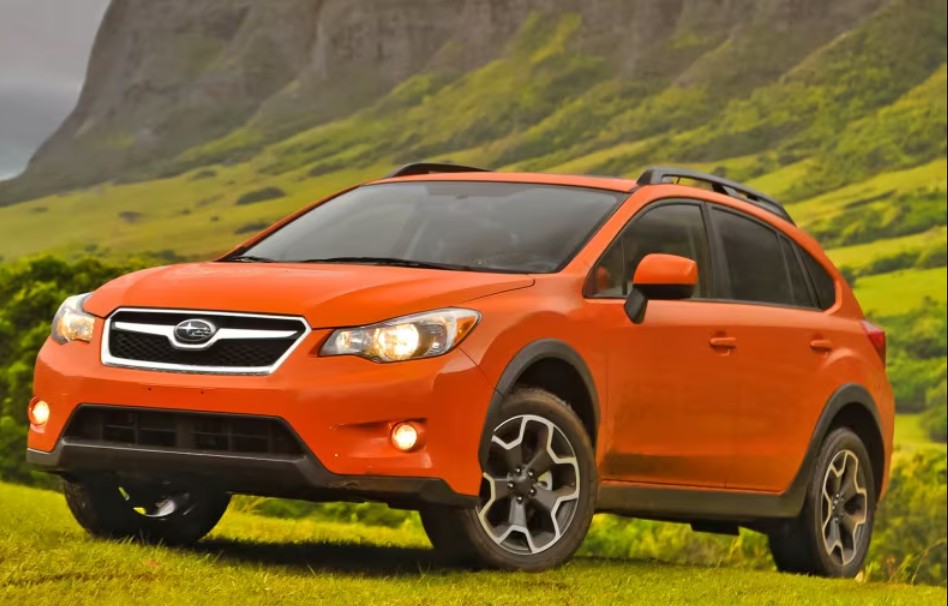
Exterior Design and Build Quality
The XV Crosstrek was Subaru’s early answer to the compact crossover trend — essentially an Impreza hatchback lifted for adventure. With chunky wheel arch cladding, bold colors, and a higher ride height, it quickly became a hit among urban explorers. Build quality remained classic Subaru: durable, well-aligned panels, and resilient paintwork.
Interior and Comfort
Inside, the XV Crosstrek offered straightforward ergonomics and decent comfort. Seats were supportive, visibility was excellent, and the materials struck a balance between rugged and modern. The ride felt smooth, absorbing rough pavement with ease.
Technology and Features
Standard features included Bluetooth, a touchscreen infotainment system, and rearview camera. Later models gained Subaru’s EyeSight safety tech, heated seats, and a better sound system. It was a compact SUV with the spirit of a big one.
Performance and Driving Experience
The Crosstrek’s 2.0-liter boxer engine made around 148 horsepower — not quick, but capable. Its symmetrical AWD and raised suspension provided genuine off-road confidence. Steering was light and accurate, and cornering stability impressed for its class.
Fuel Economy and Efficiency
One of its strong points: around 25 mpg city and 33 mpg highway. With a modest tank, it still offered good range for weekend getaways.
Practicality and Storage
Cargo volume stood at 22.3 cu ft (51.9 with seats down), fitting camping gear or daily groceries with ease. Roof rails encouraged carrying bikes or kayaks for the adventurous types.
Safety and Reliability
Consistently high safety ratings and Subaru’s proven reliability record made the XV Crosstrek a trusted choice. Owners often cite low repair costs and dependable AWD performance.
Pricing and Value
Originally priced around $21,000–$27,000, the XV Crosstrek was a value-packed crossover that offered true off-road capability at a commuter-friendly price.
Pros and Cons Summary
- Pros: Rugged design, real AWD traction, great fuel economy.
- Cons: Modest power output, basic interior materials.
Performance and Comparison
Stacked against the Nissan Juke or Jeep Compass, the XV Crosstrek offered better refinement and real AWD strength. It was an affordable trail companion that didn’t mind city life.
18. Subaru Outback Sport
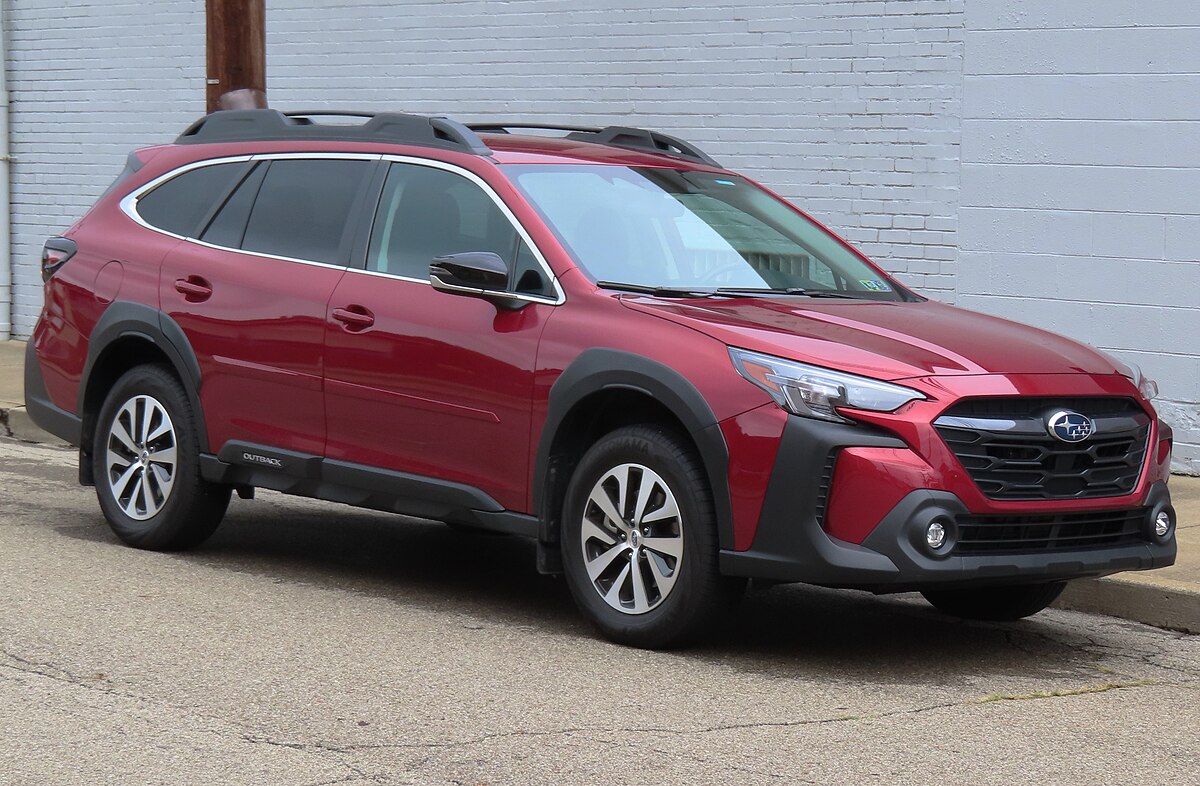
Exterior Design and Build Quality
The Outback Sport predated the Crosstrek and effectively served as its prototype. It shared its body with the Impreza hatchback but added body cladding, increased ride height, and tougher bumpers. It was Subaru’s early step into the “light adventure” market — half hatchback, half crossover.
Interior and Comfort
Cabin design was simple and utilitarian, with cloth seats and large, easy-to-use controls. Ride quality leaned slightly firm but remained comfortable for daily use. Noise insulation wasn’t luxury-level, yet perfectly acceptable for its price point.
Technology and Features
Depending on the year, buyers could get features like heated mirrors, an upgraded stereo, and optional sunroof. Its straightforward control layout has aged well, and everything feels built to last.
Performance and Driving Experience
Power came from a 2.5-liter flat-four mated to a five-speed manual or four-speed automatic. Performance was lively for a small wagon, with predictable handling and classic Subaru grip. It was fun to drive on twisty roads — a small car that felt planted and eager.
Fuel Economy and Efficiency
With roughly 20–27 mpg combined depending on transmission, it wasn’t the most frugal but delivered reliable AWD traction in all weather.
Practicality and Storage
Outback Sport owners enjoyed wagon-like cargo space — around 27 cubic feet — and a flexible cabin with folding seats. It made an excellent commuter with weekend adventure potential.
Safety and Reliability
Long before EyeSight, Subaru earned respect for its solid frames and AWD safety. Reliability remained excellent, with many Outback Sports still running decades later.
Pricing and Value
In its day, it was priced around $18,000, giving buyers an affordable, AWD-equipped alternative to front-wheel-drive compacts.
Pros and Cons Summary
- Pros: Affordable AWD, nimble handling, great visibility.
- Cons: Basic interior, average fuel economy.
Performance and Comparison
Before crossovers ruled the roads, the Outback Sport was the go-to adventure hatch. It rivaled the VW Golf 4Motion for fun and practicality in its era.
19. Subaru Outback Wilderness
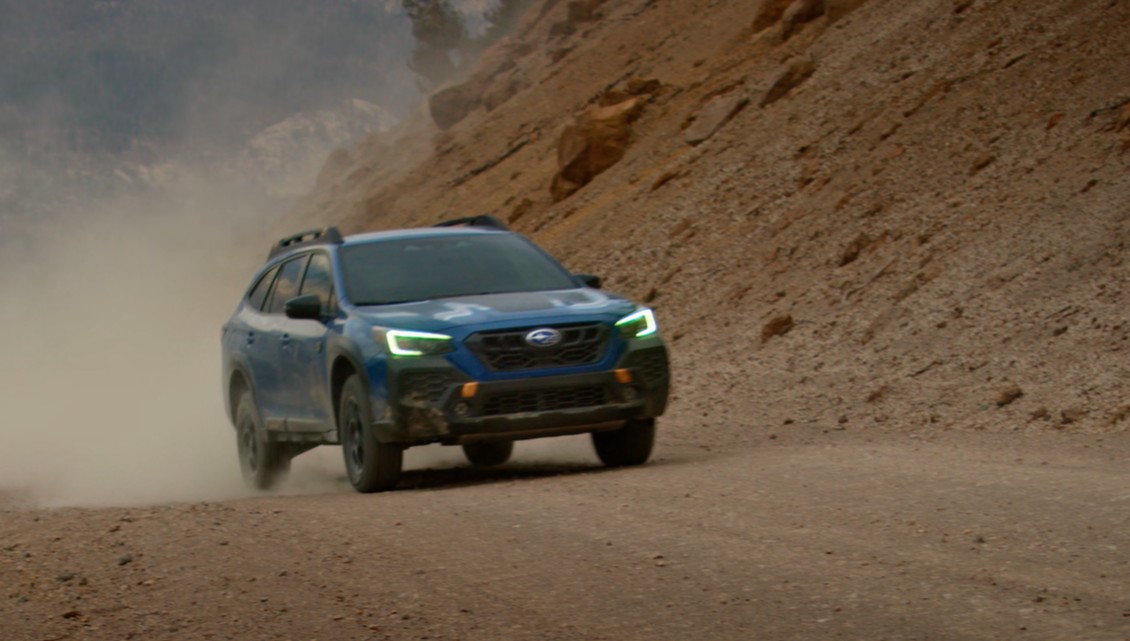
Exterior Design and Build Quality
The Outback Wilderness takes the regular Outback’s utility and turns up the off-road attitude. With increased ground clearance (9.5 inches), matte-black cladding, all-terrain tires, and metal skid plates, it looks every bit the trail conqueror. The build feels rugged and ready, yet refined enough for suburban driveways.
Interior and Comfort
The cabin features easy-clean StarTex upholstery — water-resistant and ideal for muddy adventures. The seating position feels commanding, visibility is excellent, and the ride comfort remains top-notch despite its off-road upgrades.
Technology and Features
Inside, the 11.6-inch touchscreen remains the centerpiece, loaded with navigation, smartphone connectivity, and off-road display functions. The standard EyeSight system adds adaptive cruise and lane assist, while X-Mode offers hill-descent control and traction mapping for rough conditions.
Performance and Driving Experience
The Wilderness packs the turbocharged 2.4-liter flat-four engine, offering robust torque and confident acceleration. Subaru recalibrated the CVT and suspension for off-pavement use. It feels poised both on dirt trails and highways — few crossovers blend these traits so well.
Fuel Economy and Efficiency
Expect around 22 mpg city / 26 mpg highway. Slightly lower than the base Outback, but a fair trade-off for added capability.
Practicality and Storage
Same generous cargo space as the standard Outback, with roof rails ready for tents or cargo boxes. The durable interior invites you to bring pets, gear, or muddy boots without worry.
Safety and Reliability
With all of Subaru’s safety tech included, plus reinforced underbody protection, it’s a solid choice for off-grid explorers who value dependability.
Pricing and Value
Starting around $39,000, it’s a bit pricier than the base model, but the off-road hardware makes it worth every penny for those who use it as intended.
Pros and Cons Summary
- Pros: Serious off-road ability, durable interior, powerful turbo engine.
- Cons: Slightly reduced fuel economy, higher entry price.
Performance and Comparison
Versus rivals like the Jeep Cherokee Trailhawk, the Outback Wilderness holds its own while maintaining Subaru comfort and efficiency. It’s adventure-ready right from the dealership.
20. Subaru Crosstrek Hybrid
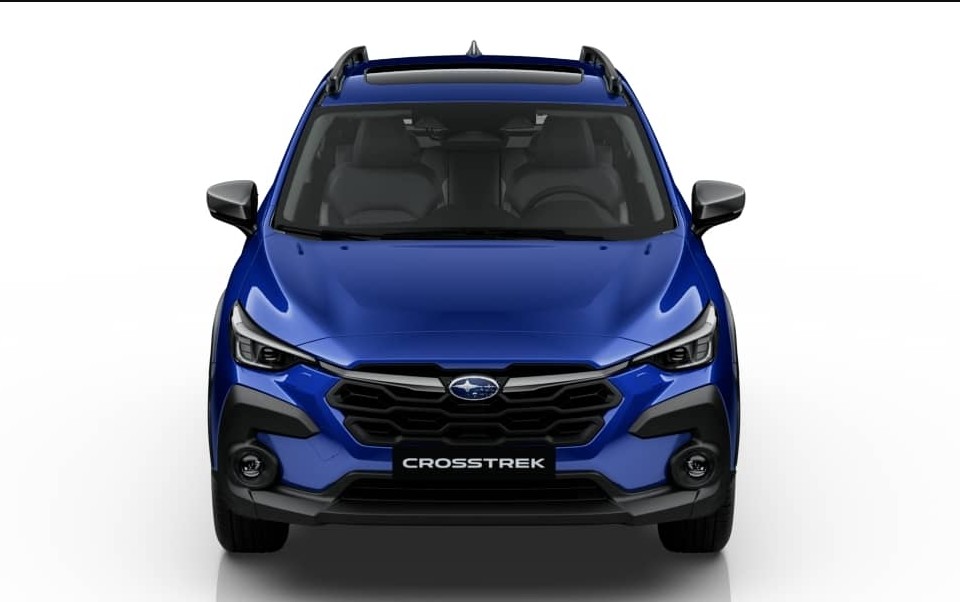
Exterior Design and Build Quality
The Crosstrek Hybrid looks nearly identical to its gasoline sibling but hides clever plug-in tech underneath. Blue accents and subtle badges are the main giveaways. Build quality remains strong, and the hybrid retains full AWD capability.
Interior and Comfort
Inside, the hybrid keeps the same ergonomic layout and adds a quieter cabin thanks to electric assistance. The materials feel slightly more premium, and the seats remain supportive on long drives. Rear space is slightly reduced due to battery placement, but still practical.
Technology and Features
The infotainment system includes hybrid-specific energy flow screens, and Apple CarPlay/Android Auto come standard. EyeSight remains part of the package, along with adaptive cruise and lane departure warning. Charging can be done via a 120V or 240V outlet, taking around two hours on Level 2.
Performance and Driving Experience
The hybrid pairs a 2.0-liter engine with dual electric motors for a combined 148 hp. It can travel around 17 miles on electric power alone before switching to gasoline mode automatically. Acceleration feels smoother and torque delivery is instant at low speeds.
Fuel Economy and Efficiency
Combined efficiency averages around 35 mpg plus electric-only range, making it Subaru’s most economical AWD vehicle. Perfect for commuters who enjoy weekend escapes.
Practicality and Storage
Cargo space shrinks slightly to 45 cu ft with seats folded, but still useful for daily errands. The raised suspension and AWD traction remain ideal for snow or gravel.
Safety and Reliability
Full suite of EyeSight safety systems, plus hybrid-related warranties, ensure peace of mind. Reliability data has been positive since launch, with no major recurring issues.
Pricing and Value
Starting near $38,000, it’s pricier than the regular Crosstrek but offers fuel savings and plug-in versatility. Eligible for select state and federal incentives.
Pros and Cons Summary
- Pros: Excellent fuel economy, smooth hybrid system, standard AWD.
- Cons: Higher price tag, smaller cargo area.
Performance and Comparison
Compared with the Toyota RAV4 Hybrid or Ford Escape PHEV, the Crosstrek Hybrid trades outright speed for rugged AWD reliability. It’s a smart bridge between gas and full-electric Subaru models.
21. Subaru Legacy
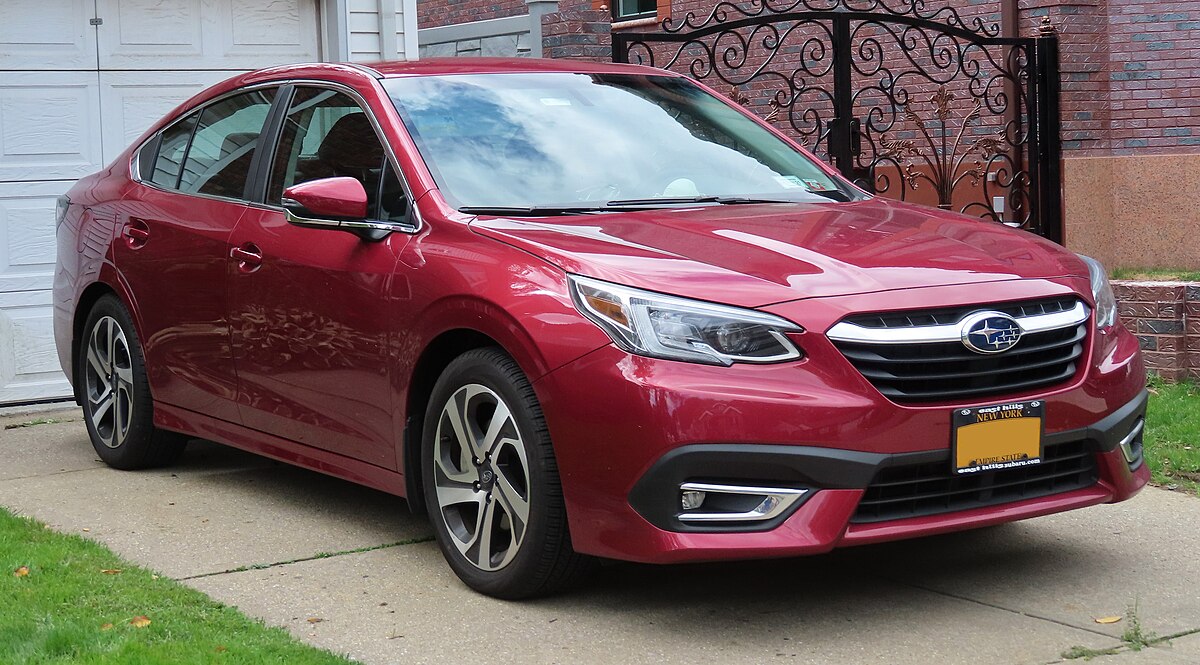
Exterior Design and Build Quality
The Subaru Legacy has long stood as the brand’s flagship sedan, and its exterior design reflects that role with an understated confidence. The latest generation shows off sharper character lines, a more prominent hexagonal grille, and sleek LED headlights. Subaru’s build quality is excellent, with tight body panels and a solid paint finish that resists chipping over time. The overall impression is conservative yet elegant — a look that appeals to drivers who value refinement over flashiness.
Interior and Comfort
Inside, the Legacy feels welcoming and mature. Materials are soft-touch across most surfaces, and the cabin insulation is impressive for a mid-size sedan. The seats are supportive for long drives, and Subaru offers heating and ventilation on higher trims. Rear legroom rivals larger sedans, making it a comfortable choice for families. The driving position is upright with good visibility — a Subaru hallmark — and controls are intuitive without feeling dated.
Technology and Features
The Legacy integrates Subaru’s Starlink infotainment system, featuring an 11.6-inch touchscreen on upper trims. Apple CarPlay and Android Auto come standard, along with available navigation and premium audio from Harman Kardon. Subaru’s EyeSight Driver Assist technology provides adaptive cruise control, lane keep assist, and pre-collision braking — all standard. Wireless charging, dual-zone climate control, and multiple USB ports add convenience for daily use.
Performance and Driving Experience
Two engines are available: a 2.5-liter flat-four producing 182 horsepower and a turbocharged 2.4-liter with 260 hp. The CVT transmission mimics gear shifts convincingly and keeps the engine in its power band. Handling is stable, thanks to Subaru’s symmetrical all-wheel-drive system, giving the Legacy confidence on both highways and slick roads. It’s not a sport sedan, but its balance and composure make it an easy cruiser for everyday driving.
Fuel Economy and Efficiency
The base engine returns around 27 mpg city and 35 mpg highway, while the turbo version averages closer to 24/32 mpg. The CVT’s efficiency tuning and AWD grip make the Legacy one of the more fuel-friendly AWD sedans in its segment.
Practicality and Storage
The Legacy’s trunk offers 15.1 cubic feet of space — enough for luggage or groceries. Split-folding rear seats expand capacity, and small storage compartments throughout the cabin make it practical for family use. Its generous visibility also aids in parking and tight urban maneuvers.
Safety and Reliability
With standard EyeSight tech and strong crash-test results, the Legacy consistently ranks among the safest sedans on the market. Subaru’s reputation for reliability extends here, with well-built engines and durable components that hold up even under high mileage.
Pricing and Value
Starting around $25,000 and topping $37,000 for the turbo Touring XT, the Legacy delivers serious value. Standard AWD, generous tech, and high safety ratings make it a smart long-term purchase.
Pros and Cons Summary
- Pros: Standard AWD, refined ride, spacious cabin, strong safety features.
- Cons: Modest base engine power, conservative styling.
Performance Comparison
Compared with the Toyota Camry AWD and Honda Accord, the Legacy feels more composed on slippery surfaces and offers better visibility. However, the Accord’s turbo engine delivers slightly sharper acceleration. For drivers prioritizing stability and comfort, the Legacy is the better long-distance companion.
22. Subaru Legacy Sedan
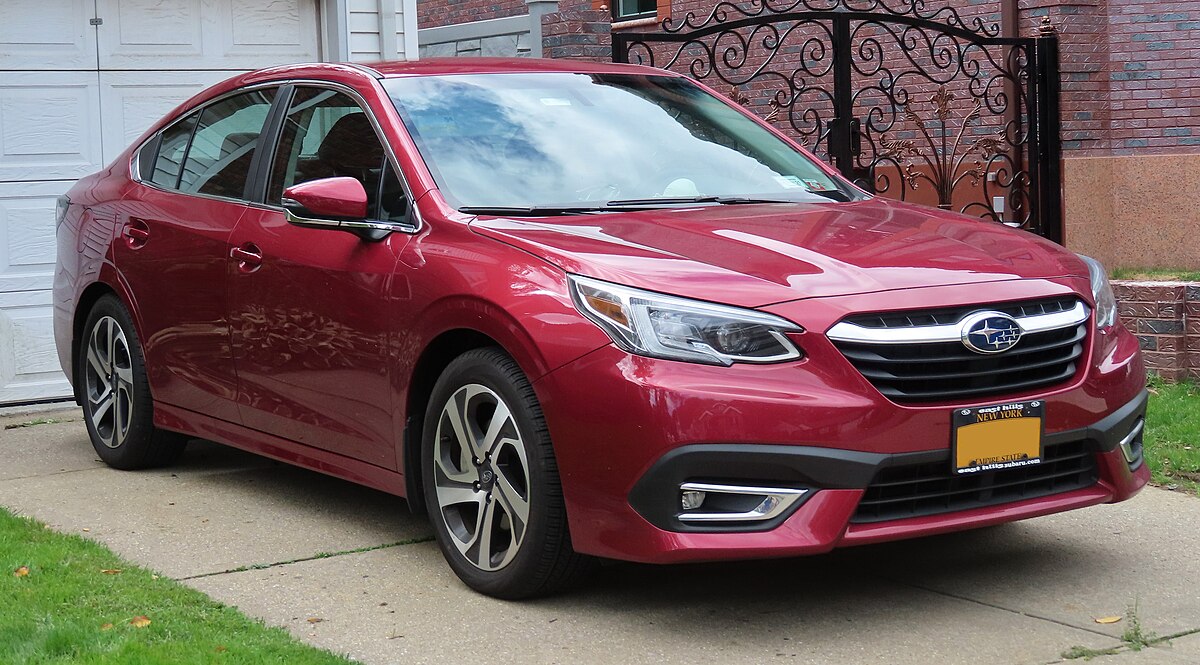
Exterior Design and Build Quality
The Legacy Sedan exudes subtle sophistication. With a broad grille, slim LED headlights, and smooth sheet metal, it strikes a mature note. Subaru’s assembly quality is high — gaps are uniform, paint depth is even, and the overall impression is premium yet modest. It’s a design that grows on you the more you live with it.
Interior and Comfort
Inside, the Legacy pampers passengers with generous space and excellent seat ergonomics. Materials are soft to the touch, and the dashboard layout feels modern. Acoustic glass and heavy insulation create a near-luxury quietness at speed. Rear passengers enjoy ample legroom, making it a true road-trip contender.
Technology and Features
The centerpiece is an 11.6-inch portrait-oriented touchscreen with Starlink infotainment. Apple CarPlay, Android Auto, and available Harman Kardon audio complete the package. Standard EyeSight adds adaptive cruise control, lane centering, and pre-collision braking. Everything feels cohesive and thoughtfully integrated.
Performance and Driving Experience
The standard 2.5-liter engine makes 182 hp, while the turbo 2.4-liter XT model bumps it to 260 hp. The CVT mimics gear shifts effectively, and handling is composed yet smooth. Subaru’s symmetrical AWD keeps it glued to the pavement during storms or spirited drives through twisty backroads.
Fuel Economy and Efficiency
The naturally aspirated model achieves up to 35 mpg highway; the turbo averages about 30. Those numbers are impressive considering the AWD system’s weight and traction advantages.
Practicality and Storage
The 15.1 cubic-foot trunk is wide and deep, and folding rear seats expand the cargo area. Numerous storage cubbies add daily convenience. Overall, the Legacy Sedan blends comfort and practicality exceptionally well.
Safety and Reliability
Year after year, the Legacy earns top safety ratings from IIHS and NHTSA. Reliability is another highlight, thanks to Subaru’s proven engines and simple mechanical layout. It’s the sort of sedan that earns trust over hundreds of thousands of miles.
Pricing and Value
Starting at $25,000, the Legacy undercuts many AWD rivals while feeling more upscale than its price suggests. Even fully loaded at around $37,000, it competes with entry-level luxury cars for comfort and features.
Pros and Cons Summary
- Pros: Smooth ride, standard AWD, upscale cabin.
- Cons: Conservative exterior, no hybrid option yet.
Performance Comparison
Against the Toyota Camry AWD and Nissan Altima AWD, the Legacy feels better planted and quieter on the highway, though slightly slower to 60 mph in base form. It’s a driver’s sedan for those who value composure over flash.
23. Subaru Legacy Wagon
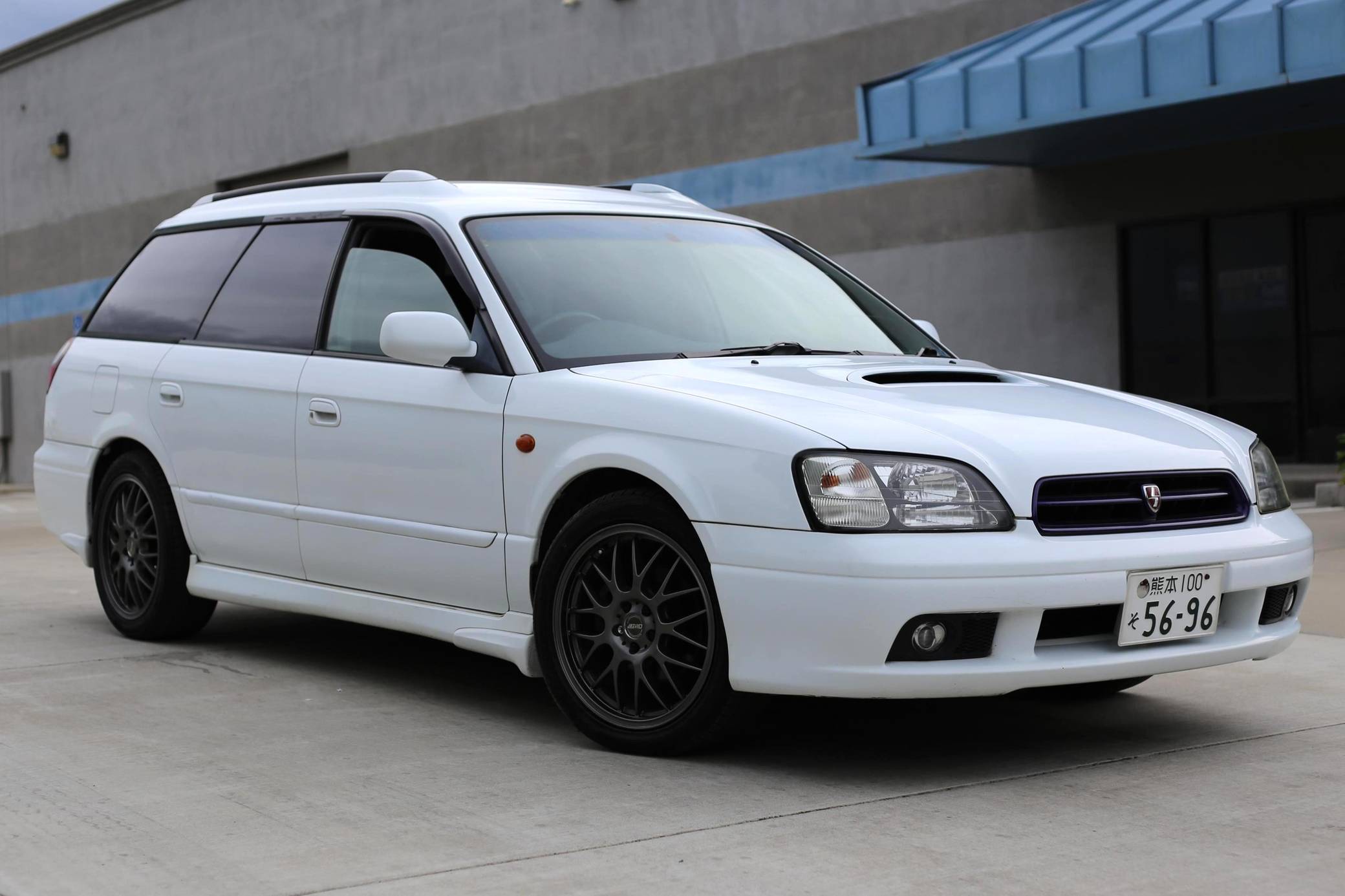
Exterior Design and Build Quality
The Legacy Wagon — a fan favorite in the 1990s and early 2000s — blended sedan comfort with SUV utility. Its boxy, functional silhouette has aged gracefully, embodying the rugged-practical Subaru ethos. Body rigidity and paint quality were excellent for its era, and the raised roof rails hinted at its adventurous side.
Interior and Comfort
Cabin materials were simple but durable. The seating position felt commanding, and the rear bench offered impressive legroom. The tall greenhouse design let in plenty of light, creating an airy environment uncommon in wagons of its time. Long-distance comfort was one of its hidden strengths.
Technology and Features
Depending on trim, the Legacy Wagon came with power accessories, a premium sound system, and — later — optional dual-zone climate control. While technology was basic by modern standards, it was reliable and easy to use.
Performance and Driving Experience
Engine options ranged from a 2.5-liter flat-four to a 3.0-liter H6. All delivered smooth torque and predictable power delivery. The symmetrical AWD system provided excellent grip, making it ideal for snowy or unpaved roads. Handling leaned toward comfort, but steering was accurate enough for confident cornering.
Fuel Economy and Efficiency
Expect roughly 22–28 mpg depending on engine and transmission. Its aerodynamic shape helped highway efficiency despite its wagon size.
Practicality and Storage
Cargo capacity exceeded 68 cubic feet with rear seats folded — nearly SUV territory. Roof rails supported additional gear, turning the wagon into a capable weekend adventure companion.
Safety and Reliability
Subaru’s chassis integrity and low center of gravity made the Legacy Wagon one of the safest long-roof cars of its day. Reliability was stellar, and many examples still roam the roads decades later.
Pricing and Value
Originally priced between $23,000 and $30,000, used models now command attention among Subaru fans. Their durability and versatility make them collector favorites in certain circles.
Pros and Cons Summary
- Pros: Huge cargo area, AWD confidence, timeless practicality.
- Cons: Outdated tech by modern standards, modest acceleration.
Performance Comparison
Against the Volvo V70 or Audi A4 Avant, the Legacy Wagon offered similar cargo space at a lower price and higher reliability. It’s still fondly remembered as the golden-era Subaru workhorse.
24. Subaru Legacy 2.5GT Limited Wagon
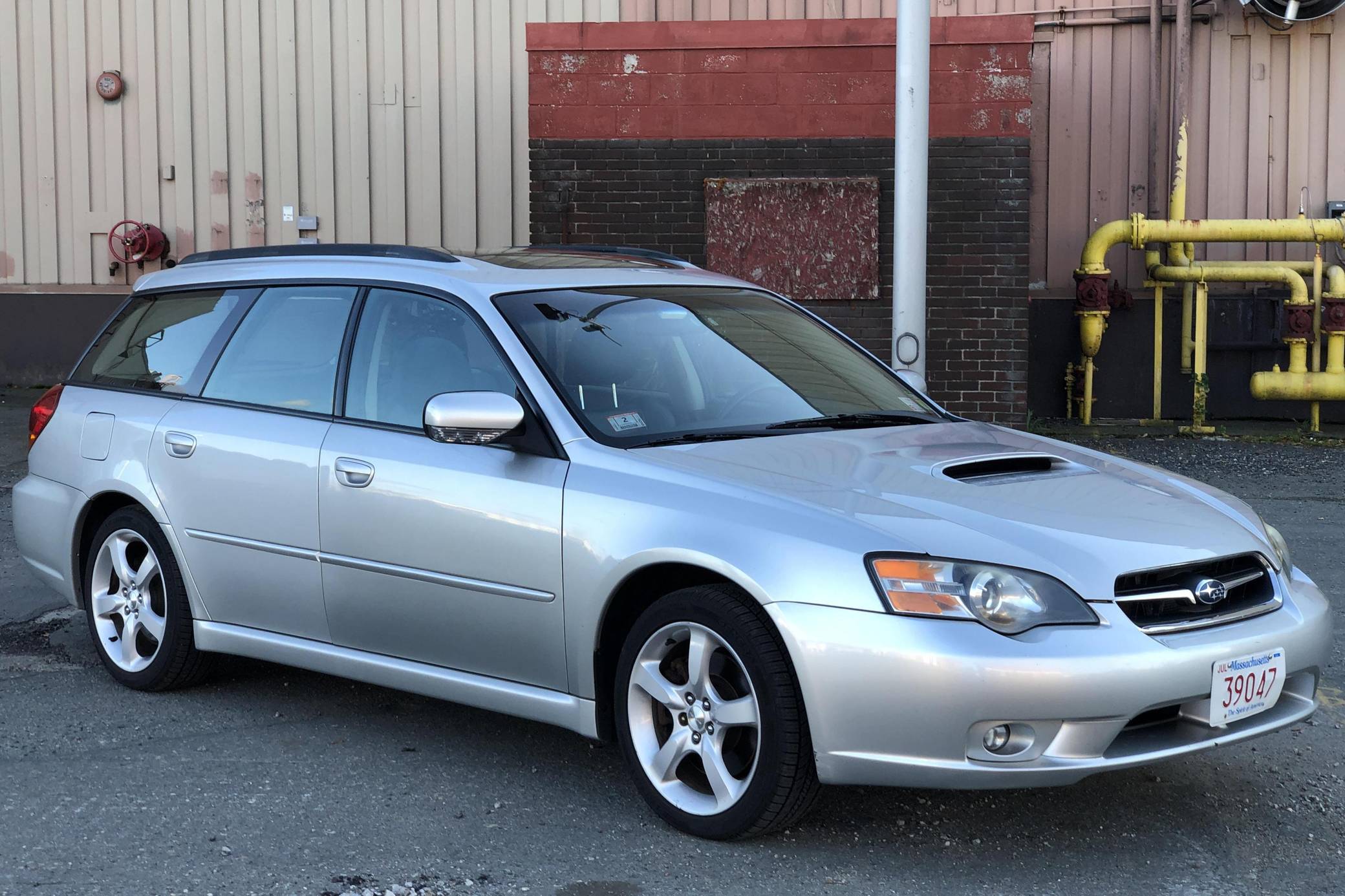
Exterior Design and Build Quality
The 2.5GT Limited Wagon represented the performance pinnacle of the Legacy Wagon line. It combined elegant styling with subtle aggression — hood scoop, sportier bumpers, and alloy wheels distinguished it without shouting. Subaru’s solid construction and tight tolerances gave it a premium, planted feel even at highway speeds.
Interior and Comfort
The interior featured leather upholstery, heated seats, and a sunroof, blending sport with luxury. Supportive bolsters and an ideal driving position made it suitable for both long trips and spirited sprints. Cabin materials were excellent for the mid-2000s, and sound insulation was notably improved over previous generations.
Technology and Features
Standard equipment included automatic climate control, premium audio, and a multi-function display showing boost pressure and fuel economy. For its time, these touches set it apart as a high-tech tourer rather than a utilitarian hauler.
Performance and Driving Experience
Under the hood, a 2.5-liter turbocharged flat-four produced 250 horsepower and 250 lb-ft of torque, paired with a five-speed manual or automatic. The symmetrical AWD system and sport-tuned suspension delivered tenacious grip. Acceleration to 60 mph came in around 5.6 seconds — astonishing for a family wagon. Steering feel was crisp, and the ride balanced comfort with athleticism.
Fuel Economy and Efficiency
EPA figures hovered near 19/25 mpg, typical for turbocharged AWD setups of that period. Enthusiasts often accepted the thirst for the grin factor it delivered.
Practicality and Storage
With over 66 cubic feet of cargo space and fold-flat rear seats, practicality remained outstanding. It could haul gear, kids, and still outrun many sport sedans on winding roads — a true multitasker.
Safety and Reliability
Dual airbags, ABS, and Subaru’s strong structure gave peace of mind. Reliability was solid with regular maintenance, though turbo upkeep demanded attentive oil changes. Owners often report these wagons lasting well past 200,000 miles.
Pricing and Value
Originally priced around $33,000, used examples have become cult classics. Their combination of wagon practicality and turbocharged thrills ensures they remain sought-after among Subaru collectors.
Pros and Cons Summary
- Pros: Turbocharged performance, huge cargo space, timeless appeal.
- Cons: Thirsty engine, rare parts availability today.
Performance Comparison
Compared with the Audi A4 Avant 2.0T or BMW 325xi Wagon of its era, the Legacy 2.5GT Limited offered similar speed and handling for thousands less. It embodied Subaru’s philosophy perfectly: practical, capable, and unexpectedly quick.
FAQ’s
1. How many Subaru car models are there?
Subaru currently offers around 9 main models globally, including the Impreza, WRX, BRZ, Legacy, Outback, Forester, Crosstrek, Ascent, and Tribeca. Some markets may have slight variations or discontinued models.
2. Is Subaru still owned by Toyota?
No, Subaru is not owned by Toyota. Toyota does own a minority stake in Subaru, about 20%, but Subaru remains an independent company.
3. What Toyota car is made by Subaru?
The Toyota GR86 sports car is co-developed and manufactured with Subaru. Subaru also builds the Toyota 86, which shares the same platform as the Subaru BRZ.
4. What are the 7 stars of Subaru?
The 7 stars in Subaru’s logo represent the Pleiades star cluster. In Japan, it’s called “Subaru,” which means “unite” or “gather together,” symbolizing the merging of companies that formed Fuji Heavy Industries.
5. Which car is better, Toyota or Subaru?
It depends on what you want. Toyota is known for reliability and low maintenance, while Subaru offers all-wheel drive and strong performance in snow and off-road conditions. For snowy regions, Subaru often wins; for long-term reliability, Toyota is excellent.
6. What brand is Subaru owned by?
Subaru is its own brand under Subaru Corporation (formerly Fuji Heavy Industries). Toyota owns a minority stake but does not control the company.
7. What does Subaru mean in Japanese?
In Japanese, “Subaru” means “to unite” or “come together,” and it also refers to the Pleiades star cluster, which is why the logo features 6 stars representing the companies that merged.
8. Are Subarus expensive to maintain?
Subarus are moderately priced to maintain. Routine maintenance is straightforward, but repairs can be slightly higher than Toyota due to specialized AWD components and boxer engines.
9. Who makes Subaru engines?
Subaru manufactures most of its engines in-house, mainly at its Gunma and Oizumi plants in Japan. The engines are mostly flat-four “boxer” designs, with some flat-six engines for performance models.
10. Which Toyota has a Subaru engine?
The Toyota 86 and GR86 use Subaru’s flat-four boxer engine. These are Subaru-built engines tuned to Toyota’s specifications.
11. Where is Subaru built?
Subaru cars are mainly built in Japan, at plants in Gunma and Oizumi. Some models, like the Ascent and Outback for North America, are also assembled in Lafayette, Indiana, USA.
12. Which is faster, Toyota GR86 or Subaru BRZ?
Both cars share the same platform and engine, so performance is nearly identical. Minor differences in tuning and weight may give a slight edge to the latest GR86 in some conditions.
13. How long do Subarus typically last?
With proper maintenance, Subarus can last 200,000–300,000 miles. Many owners report 15+ years of reliable use, especially with the AWD system well cared for.
14. What does Kia mean in Japanese?
Kia is a Korean brand, not Japanese. In Korean, it roughly means “to arise from Korea” or “come out of Korea,” but it doesn’t have meaning in Japanese.
15. Does Subaru use Toyota parts?
Subaru uses some Toyota parts, especially in shared models like the BRZ/GR86. However, most Subaru models use in-house parts, particularly engines and AWD components.
16. What is the most common problem with Subaru engines?
Older Subaru engines, especially early 2000s models, are prone to head gasket leaks. Modern models have improved, but oil consumption in turbocharged engines can still be an issue if not maintained.
17. Do Subarus have Porsche engines?
No, Subarus do not use Porsche engines. Subaru engines are mostly flat-four or flat-six boxer engines built by Subaru themselves.
18. Is Mazda owned by Subaru?
No, Mazda is not owned by Subaru. Both are separate Japanese automakers with no ownership connection.
19. Who owns most of Subaru?
Subaru Corporation is publicly traded. Toyota owns about 20% of Subaru, making it the largest single shareholder, but Subaru is still independent.
20. Which is more reliable, Honda or Subaru?
Honda generally ranks higher for long-term reliability. Subaru is very reliable too, but boxer engines and AWD systems may require more attention over time.
21. Is the Subaru Outback being discontinued?
No, the Subaru Outback is not being discontinued. It continues to be a popular crossover wagon and Subaru’s best-selling model in many markets.
22. What car did Subaru and Toyota make together?
Subaru and Toyota co-developed the Subaru BRZ and Toyota 86/GR86 sports cars. They share platforms, engines, and many components.
23. What is the famous Subaru engine?
The Subaru EJ series engine is very famous, especially the EJ25 turbo engines in the WRX and WRX STI. The FA and FB series are also well-known for reliability and efficiency.
24. Is the Subaru 2.4 L engine reliable?
Yes, the 2.4L Subaru engines, like the FA24 used in the Outback and Forester, are generally very reliable, with proper maintenance and regular oil changes.
25. Does Subaru make airplanes?
Subaru’s parent company, Subaru Corporation, originally evolved from Fuji Heavy Industries, which produced airplanes. Today, Subaru itself does not make airplanes, but the parent company still has aerospace divisions.
26. Who owns Volvo now?
Volvo Cars is owned by Geely, a Chinese automotive company. It is separate from Volvo Trucks, which is Swedish-owned.
27. What was Subaru originally called?
Subaru was originally part of Fuji Heavy Industries (FHI) and became Subaru Corporation in 2017. The car brand “Subaru” has been used since the 1950s.
28. In what country does Subaru sell the most cars?
Subaru sells the most cars in the United States. The Outback and Forester are particularly popular in North America.
29. What car brand is the most reliable?
Brands like Toyota, Lexus, and Honda are often ranked as the most reliable worldwide. Subaru is also reliable but slightly behind these brands in long-term rankings.
30. Who owns Jaguar?
Jaguar is owned by Tata Motors, an Indian automotive company, which also owns Land Rover.
31. Is Honda better than Subaru?
“Better” depends on your needs. Honda generally scores higher in reliability and fuel efficiency, while Subaru offers AWD, better performance in snow, and rugged utility.
32. Why is Subaru associated with LGBTQ?
Subaru has earned a reputation as LGBTQ-friendly due to its inclusive marketing, sponsorships, and culture promoting equality. It is not inherent to the cars themselves.
33. How to tell if a Subaru is made in Japan?
You can check the Vehicle Identification Number (VIN). If it starts with “JF1” or “JF2,” it was manufactured in Japan. Other codes indicate plants in the USA or elsewhere.
34. Are Subarus good for long trips?
Yes, Subarus are great for long trips. AWD, comfortable seating, and cargo space make them ideal for road trips and outdoor adventures.
35. Will a Subaru last 300,000 miles?
Yes, with proper maintenance, many Subaru owners report reaching 300,000 miles. Regular oil changes, timing belt checks, and care for the AWD system are key.
36. What is the #1 most reliable car?
Toyota Corolla and Honda Civic are often rated the most reliable cars globally. Subaru Outback and Forester also rank high but slightly below Toyota and Honda.
37. Are Subarus good in the snow?
Yes, Subarus are excellent in the snow thanks to standard all-wheel drive, good ground clearance, and stability control systems.
38. Which Subaru is made by Toyota?
No Subaru is fully made by Toyota, but the Subaru BRZ shares development and engines with Toyota’s 86/GR86 models.
39. Who merged with Subaru?
Subaru originated from the merger of six Japanese companies to form Fuji Heavy Industries. The brand name and logo reflect this union.
40. Why does Subaru look like Toyota?
Subaru cars may look similar to Toyota in design due to the collaboration on certain models like the BRZ/GR86. Otherwise, design similarities are coincidental or influenced by shared market trends.
Final Thoughts: Subaru’s Legacy of Innovation and Reliability
After exploring 24 remarkable Subaru car models, one thing stands out — Subaru has mastered the art of building cars that feel like loyal companions rather than just machines. From the rally-inspired WRX STI to the family-ready Outback and the futuristic Solterra, each model carries Subaru’s signature blend of safety, all-wheel-drive confidence, and long-term dependability.
Subaru isn’t about chasing flash or luxury headlines — it’s about making every drive feel steady, secure, and authentic. Whether you crave the precision of a sports coupe, the practicality of a crossover, or the space of a family wagon, Subaru offers a lineup that speaks to both the heart and the head. The company continues to evolve with hybrid and electric innovations, yet stays true to its core: building cars that can take you anywhere, in any weather, with a smile.
If you’re comparing different Subaru car models for your next purchase, remember that most share the brand’s signature strengths — symmetrical AWD, boxer engines, and a reputation for safety that few automakers match. What sets them apart is personality: the BRZ’s agility, the Forester’s versatility, or the Legacy’s refinement. No matter which one wins your garage space, you’re joining a global community that values capability, comfort, and confidence.
